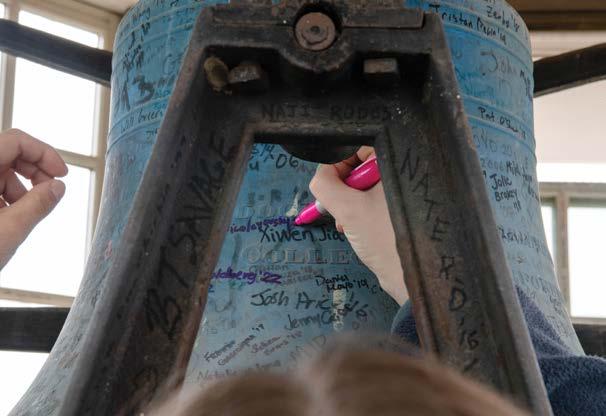Spotlight on Ira Reid
Celebrating Haverford’s first Black professor


Spotlight on Ira Reid
Celebrating Haverford’s first Black professor

Michael B. Kim ’85 P’17 found success in doing the right thing. Now, his gift to the College will help others do the same.
A Journey of Reconciliation
Fords experience the Civil Rights Trail firsthand
Taking Home an Emmy
Jonathan Miller ’01 wins for his work on a baseball documentary
SPRING/SUMMER 2024
Editor
Jill Waldbieser
Class News Editor
Prarthana Jayaram ’10
Photography Editor
Patrick Montero
Graphic Design
Anne Bigler
Editorial Director
Dominic Mercier
Associate Vice President for College Communications
Chris Mills ’82
Vice President for Institutional Advancement
Kim Spang
Contributing Writers
Charles Curtis ’04
Brian Glaser
Debbie Goldberg
Lini S. Kadaba
Eils Lotozo
Patrick Rapa
Ben Seal
Anne Stein
Contributing Photographers
Holden Blanco ’17
Grace Fang ’27
Reesha Gandhi ’24
Alexandra Iglesia ’21
Jingzhe Jiang ’25
Jessica Korgen ’24
Ella Mbanefo ’26
Ryan Murray
Paola Nogueras
Alley Rutzel
Jonathan Yu ’12
Haverford magazine is published three times a year by College Communications, Haverford College, 370 Lancaster Avenue, Haverford, PA 19041, 610-896-1000, hc-editor@haverford.edu ©2024 Haverford College
SEND
Haverford College 370 Lancaster Avenue Haverford, PA 19041 or devrec@haverford.edu


30 Tell Us More
Madeline Kreider Carlson ’10: Showing the Value of Fair Trade. By
Anne Stein
32 Stepping Up
Michael B. Kim ’85 P’17 found success in doing the right thing. Now, his gift to the College will help others do the same.
By Lini S. Kadaba
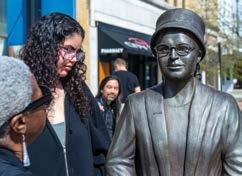
Several significant alumni gifts have laid the groundwork for the Haverford 2030 strategic plan, which promises to deliver better learning with a broader impact.
By Lini S. Kadaba
40 A Journey of Reconciliation
On a spring break trip organized by Haverford’s Institutional Diversity, Equity, and Access division, students, staff, and faculty got an in-depth look at the Civil Rights Trail, and a glimpse into the country’s fractured history.
By Patrick Montero
44 Full Service
After a successful career in the nonprofit world, Joy Zarembka ’94 chose a thriving D.C.-area restaurant group where arts, culture, and opportunity are on the menu as her second act. Her goal, then and now: make the world a better place.
By Eils Lotozo
50 Risks & Rewards
As the 10th anniversary of Haverford’s Microfinance and Impact Investing Initiative passes, students continue to reap the benefits of a program that provides real-world experience.
By Ben Seal
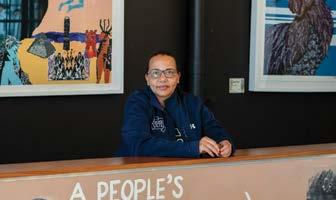
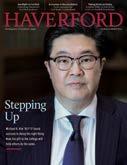

Haverford is a place of sustained listening and querying that drives our deep capacities to learn. I have been struck by these Haverford superpowers as our community created Haverford 2030, navigated global crises, and everything in between. Cultivating curiosity toward learning—the Quaker value of living a life of continuing revelation—is a Haverford hallmark.
I’ve thought about this often since Alumni Weekend, which placed an exclamation point at the year’s end with its ebullient display of the distinctive impacts of a Haverford education. It was wonderful to have hundreds of alums return to campus, with hundreds more friends and family. It is my privilege to be immersed among the friendships and journeys launched on this inimitable campus. Haverford is enriched by your presence, queries, and energy, as am I.
Early on Sunday morning, toward the end of Alum-
ni Weekend, I joined the Class of 1974 at the Haverford Meetinghouse for their 50th reunion Quaker meeting. Through the welcome quiet of our fellowship, Fords offered memories of departed classmates, their time at Haverford, or paths since then. They recounted indelible friendships and impactful experiences with emotion and sincerity, whether through song, humor, or heartfelt inspiration. I was deeply moved. In a manner common to how Quaker meetings can work, the “pebbles” of what was spoken and the “pebbles” of the silences caused ripples in my day and for days afterward. This column is one of those ripples.
A pamphlet provided at the seats of the Haverford Meetinghouse included advice to wait several minutes after someone spoke, in order to allow everyone time to absorb and reflect. I saw, in action, what it meant when the gathering offered time for us to take in, and thus listen deeply, to what was shared.
I also experienced in that gathering of classmates and loved ones what it felt like when almost no time was allowed to pass before an individual rose to speak. Each sharing offered glimpses into the sharer and what was important to them that morning. I gained a better understanding of what it can mean to be connected within a Haverford class for over 50 years. By their presence alone, I learned how much these Fords honor their connections to one another and with those no longer walking the Earth. Empathy, grief, joy, tenderness, discovery, questions, and wonder were very much alive in that meetinghouse, lit only by the sunshine coming in through the windows and the hearts and minds of those present.
As the impacts of the meeting rippled through me on my walk home—via the Dining Center, where hundreds more alums gathered to say their goodbyes before hitting the road—I thought about my experiences with listening and of spaces filled with speech instead of listening, across Alumni Weekend and the past year.
During the weekend, I had many conversations with alums about what has been happening on our campus since Oct. 7. Not unlike my experience with Sunday’s 50th reunion gathering, some of those conversations did not include literal space, or pause, for listening. On the one hand, that is not surprising, even though it has not generally been my experience with Fords: time feels limited, emotions run high, and one wishes to make one’s point. Certainty in one’s own views can dominate. On the other hand, I was struck by how these interactions with Haverford alums paralleled experiences on campus when “certainty” eclipsed curiosity. In such instances, advancing learning and discovery was pushed aside, as was building community.
And here’s a lovely counterpoint: many of those Alumni Weekend conversations included contributions by alums committed to listening and learning. Alums stepped in to say, “Let her speak,” or, “I am a parent of a current student, and my student’s experience has been quite different from what I’m hearing you say,” or, “Ah! What I’ve heard in this conversation is ‘xyz’….” These contributors expanded the conversation by listening.
This brings me to a touchstone for us in Isaac Sharpless’s timeless words from 1888, through which we
are reminded of the power of teaching and unbounded discernment in shaping our views:
“I suggest that you preach truth and do righteousness, as you have been taught, whereinsoever that teaching may commend itself to your consciences and your judgments. For your consciences and your judgments we have not sought to bind; and see you to it that no other institution, no political party, no social circle, no religious organization, no pet ambitions, put such chains on you as would tempt you to sacrifice one iota of the moral freedom of your consciences or the intellectual freedom of your judgments.”
When listening and curiosity are embedded in the cycle of teaching and learning, we are at our highest learning potential, and at our best. Listening and querying are essential to learning. And as I said at the start, I think they are Haverford superpowers.
Interestingly, Sharpless’s words do not invite us to consider how we build community even as we vociferously disagree. Each person’s commitment to community is a central Quaker value, and we see the attraction to this value and the varied ways we bring it to life, from applicants to alumni. Our Honor Code guides students and all of us in how to build community based on our institutional values of trust, concern, and respect. Building an inclusive Haverford community in which every person can thrive is a continuous, evergreen, and essential endeavor.
Upon arriving back at my office on Monday after Alumni Weekend, I received an email from one of the alums who had confronted me during the weekend. The subject line, “Thank you,” spoke volumes about that person’s grace and openness, and the power listening has to create dialogue and community. I hope you will join me in embracing listening as we build relationships, learn, and work together to make Haverford the best it can be. In a world with limited room for listening and querying, our willingness to be different stands out—and makes all the difference.
With gratitude,

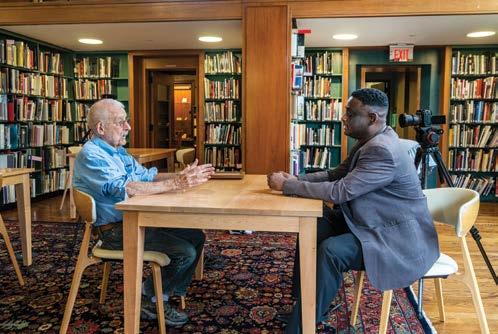
Director Rel Dowdell, (right) interviews Roger Lane, emeritus professor of history, in the Philips Wing of the Lutnick Library. Lane, a producer on the film, was approached by a former student with the idea for a documentary and wholeheartedly backed it.
During their 50th class reunion in 2019, Steven Bailey ’69 and Stephen Washburn ’69, who had been freshman roommates, got to talking about Ira Reid. A sociologist whose research focused on Black life in America, Reid became Haverford’s first Black professor in 1948, chairing the department of sociology and anthropology until his retirement in 1966. Earlier in his career, Reid, who became a Quaker, collaborated closely with W.E.B. DuBois at Atlanta University and mentored Rev. Martin Luther King Jr. while working for the National Urban League. He later
brought King to Haverford for a special summer study program.
Reid had been a beloved professor of Bailey’s when he was a student, and more than half a century later, he and Washburn discussed the need to awaken the campus community and beyond to Reid’s importance.
It was a conversation Washburn, a retired minister, would recall a year later, in the wake of the 2020 murders of George Floyd and Breonna Taylor. He was searching for examples of how to deal with these kinds of injustices, and found one in the life of Reid.
The result of that lightbulb moment is a fulllength documentary titled Dr. Ira Reid: Haverford College’s Unsung Scholar Activist, which recently was screened on campus at Alumni Weekend. The film premiered at the International Black Film Festival in Nashville in September 2023, and has had additional screenings, including one sponsored by the Rhode Island Historical Society and Rhode Island Black Film Festival in February 2024. Washburn, the film’s executive producer, launched the Ira Reid Foundation to help raise more than $80,000 over the past four years to pay for production costs. The project also involved the support of a number of other Haverford figures, credited as producers, including Bailey, James Pabarue ’72, Assistant Dean of the Office of Multicultural Affairs Denise V. Allison (now retired), and Professor of Fine Arts William E. Williams. Aiding the research process for the film were College Archivist Elizabeth Jones-Minsinger and student research intern Taylor Johnson ’24
The first person Washburn contacted about the idea for the documentary was his senior history project adviser, Professor Emeritus of History Roger Lane, who also gets a producer credit on the film. “I asked him if he believed a documentary film about Ira Reid was needed,” Washburn says. When Lane said yes, Washburn began moving forward, tapping Rel Dowdell as director. Dowdell, whose previous documentary Where’s Daddy? (2018) looks at the interplay of race and the flawed child support system in the United States, says about the film, “There are a lot of unsung African Americans like Dr. Reid who need their stories told. This is an opportuni-

ty for Haverford to showcase one of its own.”
Early in the production process, Dowdell came to campus to shoot a series of interviews, including several with Haverford professors who knew Reid during his tenure here. Among them: Roger Lane, Professor Emeritus of French Marcel Gutwirth, and Professor Emeritus of Psychology Sidney Purloe (deceased). Also interviewed were President Wendy Raymond, sociologist Sarah Willie-LeBreton ’86, now the president of Smith College, and Robert Young ’53, who had Reid as an adviser while at Haverford.
Dowdell did additional interviews off campus, including one with philosopher Cornel West, author of Race Matters, who remarked, “It’s about time that this story is told.”
Washburn and Bailey, of course, agree. “In our lifetimes, we have a succession of teachers that instruct and guide us, but there are only a few who really stand out in your memory,” says Bailey. “Dr. Reid was by far and away the best teacher I ever had, and, I would have to say, the smartest man I ever met.”
—Eils Lotozo, with additional reporting by Natalie Pompilio
This still image of Reid in front of Roberts Hall was taken from a 16 mm film that is the only known footage of Haverford’s first Black professor.
Haverford has joined eight other peer institutions in Pennsylvania and North Carolina to bring an innovative, large-scale solar facility online in western Kentucky. The Sebree Solar II project is set to begin construction next year and begin its commercial operation by the end of 2026. When complete, it will provide enough energy each year to power more than 24,000 homes. Read more about the project at hav.to/jtt.
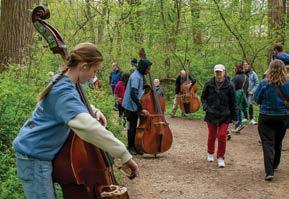
An outdoor orchestral performance. Earlier this spring, Haverford’s Nature Trail was resonant with the tones of double bass as the Network for New Music presented “A Murmur in the Trees,” a live outdoor performance to honor late bassist Robert Black. Twenty-four bassists, elementary age through adult, performed the 30-minute composition, while attendees took in a unique listening experience based on their chosen path through the woods.
THE GEST CENTER TURNS 50. The estate of artist Margaret Ralston Gest donated the building that now houses offices and classrooms for the religion and philosophy departments, and after a 2018 renovation, a student-centered lounge. See her artwork in the space, which celebrates half a century as a Haverford facility.

Drag Ball returns! This widely popular student-organized celebration of self-expression is back after a hiatus last year, and was co-emceed by Leo Brainard ’27 and Marisol Espinoza Viera ’18 , whose drag personas are Robyn Banx and Marisol, respectively. This year’s installment, which took place in Founders Hall during Haverfest, focused on the history of ballroom and drag at Haverford.
THE “BEYOND THE FLOATING WORLD EXHIBITION” CURATED BY STEPHANIE WANG BMC ’24. The collection of woodblock prints from the private collection of Arnold Satterthwait ’66, as well as many of the tools and pigments used to make them, offer a glimpse into Japanese culture and society during the Edo period (1603–1868). The exhibit was on display in the Lutnick Library through July 5.

The Mayuri x Bounce Showcase. The April 6 showcase, which took place in the Marshall Auditorium, was supported by the E. Clyde Lutton 1966 Memorial Fund, which was established in 2001. A collaboration between two campus dance groups, the show combined elements of South Asian fusion and hip hop. Videos of the performance can be viewed at hav.to/koo.
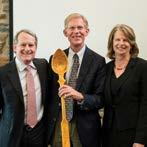
The most recent “Spoon Man.”
Beginning in 1873, each graduating class of Fords would vote for the student they most admired and award the winner a large, carved ebony spoon and corresponding title of “Spoon Man.” Though the tradition was retired some time ago, the practice returned this spring to honor outgoing board chair Charley Beever ’74, shown here, CENTER, with Alex Robinson ’96 and Haverford President Wendy Raymond. Beever was surprised with a "Spoon Man" award custom made by Wisconsin-based master artisan Derek Brabender.
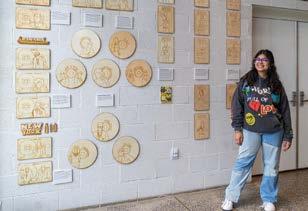
The “Deconstructing Bad Bunny” exhibit. Following a summer internship at the Hasta ’Bajo Project in San Juan, Puerto Rico, Lyali Pereda Figueroa ’26 created an exhibition featuring laser-cut images of iconic reggaetón artists. The installation, which was on view at the Visual Culture, Arts, and Media (VCAM) facility last fall, was featured at Taller Puertorriqueño arts and cultural center in North Philadelphia this spring.
The special guest at this year’s “Strange Truth” film series.
The annual showcase at Bryn Mawr Film Institute featured a live appearance by Sam Green, the Oscar-nominated director of 32 Sounds, who narrated as his immersive documentary was screened. Audience members were given headphones to experience the binaural audio in a truly unique sensory experience.
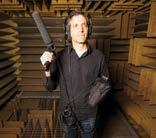
THE COLLEGE’S CONTINUED REPUTATION AS A FULBRIGHT
SCHOLAR PRODUCER. With four new 2023–2024 recipients of the prestigious award, Haverford was recognized for the eighth time in nine years by the U.S. Department of State, an honor that speaks to the quality of education students here consistently receive.
The Festival of Colors, Love, and Spring. In honor of Holi, the annual Hindu celebration of spring, the South Asian Society (SAS) hosted an event on Barclay Beach where students arrived wearing white clothing and were given packets of washable pigment to throw on each other, symbolizing a season bursting with color.


he College held its 186th Commencement on May 18, a celebration long awaited by the 334 members of the Class of 2024. For many, donning a cap and gown to cross the stage and receive a diploma was a moment eight years in the making, thanks to widespread high school commencement cancellations during the height of the COVID-19 pandemic. On a drizzly Saturday, that moment finally arrived.
TAs parents and loved ones arrived on campus to find their seats and programs, excitement rippled through the growing crowd of soon-tobe graduates as they lined up in the Douglas B. Gardner ’83 Integrated Athletic Center. At 10 a.m., the procession entered Alumni Field House to
boisterous cheers and applause that the weather stood no chance of dampening.
Maria Reyes Pacheco ’24 and Jorge Paz Reyes ’24, Students’ Council co-presidents, delivered greetings from the Class of 2024. In their remarks, they highlighted the unique circumstances and challenges students grappled with during their time at Haverford, including climate change, the nation’s gun violence epidemic, racial injustice, and violence in Israel and Gaza.
“Throughout these four years, we have continued to express ourselves in radical ways, demonstrating that Haverford is not just a college, but a diverse and expressive community,” Paz Reyes said.
Presiding over the exercises, Haverford President Wendy Raymond celebrated the gradu-

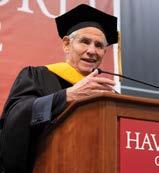
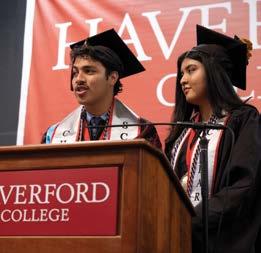
ates’ propensity for curiosity, a trait, she said, that fuels learning, discovery, and critical thinking. As the members of the Class of 2024 embark on the next phase of their lives, they do so steeped in the values of the College, she said.
“I know you will carry the ethos of the Honor Code with you, believing in yourselves, and investing in making the world a better place,” Raymond said. “I know you will bring with you the incredible gifts your classmates, friends, staff, and faculty have bestowed upon you.”
Additional speakers included Bryn Mawr College President Kimberly Wright Cassidy, Alumni Association Executive Committee
President Beverly Ortega Babers ’84, and Ashok Gangadean, the Emily Judson Baugh Gest and John Marshall Gest Professor of Global Philosophy, who lauded the class for blossoming “even amidst facing urgent existential challenges.”
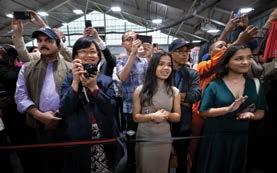

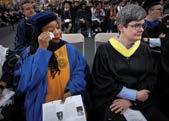

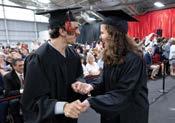
For 166 years, the College has recognized those whose lives and work reflect its mission and values through the awarding of honorary degrees. This year’s honorees were mindfulness pioneer Jon Kabat-Zinn ’64 and Dr. Ala Stanford, who received international recognition for creating the Black Doctors COVID Consortium in Philadelphia.
Kabat-Zinn encouraged the students to live in the moment, without judgment, while Stanford shared several mantras she wished had been imparted at her own graduation. Of the many she shared, one was particularly poignant as the Class of 2024 steps away from Haverford’s tight-knit campus.
Jon
friends
council Co-Presidents Maria Reyes Pacheco ’24 and Jorge Paz Reyes ’24 (4); a soon-to-be graduate (5); President Wendy Raymond (6); Vice President for Institutional Equity and Access Nikki Young and Chief Information Officer Megan Fitch (7); two excited Fords celebrating their accomplishments (8).
—Dominic Mercier
“Some people on your journey may not be there when you arrive at your destination,” she said. “Your group and tribe may change, but it doesn’t mean you don’t love or care for them. You just may have to come back to visit as you travel along your way.”
Fords’ record of excellence continued again this year as students and recent alums received prestigious prizes. Here’s where this year’s award winners are headed and what they’ll study.
For Anagha Aneesh ’24, activism and science go hand in hand. Since high school, the physics and chemistry double major has been vocal in sounding the alarm about climate change, especially its disproportionate impact on marginalized communities. Now, she’ll use her recently awarded Fulbright Scholarship to travel to Germany and investigate the potential of redox flow batteries, a scalable and greener alternative to lithium-ion batteries that could help wean the world off fossil fuels. Aneesh also received a National Science Foundation Graduate Research Fellowship but opted to pursue the Fulbright opportunity.
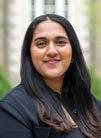
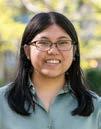

With two parents who have long worked in public and higher education, Maya Antonio ’24 grew up understanding the importance of creating engaging and inclusive learning environments, a regular dinner table topic for her and her family. The double major in linguistics and education will explore ways to shift the classroom dynamic to one that is more inclusive of all languages, cultures, and personalities. She’ll travel to Taiwan where she’ll be embedded in an elementary school to cultivate “joy, connection, and community” in the country’s educational system.
When August Muller ’23 heads to Germany in September, she will be pulled there by two sep-
arate, but equally powerful, forces: interstellar gravitational waves and her keen interest in the German language. Muller, a physics major and a German minor, will join an international, multidisciplinary team of scientists led by Alessandra Buonanno at the Max Planck Institute for Gravitational Physics (Albert Einstein Institute) in Potsdam. There, she’ll contribute to our knowledge of black holes and help develop tests that reach beyond Einstein’s theory of general relativity.
A math major, Aamina Dhar ’25 will explore the possibilities of medical imaging, computational modeling, and artificial intelligence to uncover innovative methods to diagnose schizophrenia in its earliest stages. She entered Haverford as a prospective neuroscience major but switched majors to strengthen her foundation in pure math concepts after learning about new research that identifies structural landmarks on the brain that may signal the development of diseases like schizophrenia or Alzheimer’s.

After obtaining a Ph.D., Gabe Jones-Thomson ’24, a chemistry major, hopes to embark on a career in organic chemistry that will yield discoveries of new synthetic tools for selectively constructing biologically active, medicinally relevant molecules. New techniques that are sustainable, low-cost, and that can offer unique access to complex structures, he says, are critical for the development of novel pharmaceuticals, agrochemicals, and materials.
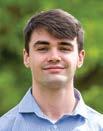
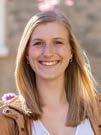
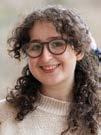
Inspired by the close relationship she has enjoyed with her grandparents and informed by her experiences working in a memory care facility, Annie Barrett ’24 will explore how differing approaches across cultures inform elder care. Barrett, a neuroscience major, will travel across South America, Africa, and Japan, before ending in the Netherlands, the site of the world’s first dementia village, which instills autonomy in patients and allows them to lead normal-seeming lives in a safe environment.
Emma Schwartz ’24 can trace a “fundamental discomfort” with the idea of incarceration back to her childhood. Her engagement in activism and organizing began in high school and continued during her time at the College. Schwartz, a double major in comparative literature and anthropology, will leverage her fellowship to travel to Ecuador, Chile, New Zealand, the Philippines, and Kenya to examine how communities and organizing efforts worldwide empower people to pursue abolitionist work.
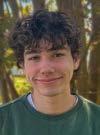
Because of his enduring commitment to service, Patrick Kelly ’25, a political science and French double major, is one of 142 young leaders hailing from 38 states, Washington, D.C., and Mexico, that comprise the 2024–2025 cohort of Newman Civic Fellows. Through the yearlong program, which recognizes students with exceptional leadership potential, Kelly will have access to a wide range of
learning and networking opportunities that will bolster his ability to enact positive change in the communities he serves.
At the University of North Carolina at Chapel Hill, Charlotte Scott ’21 plans to study fabulist and magical realist writing by women and queer people while simultaneously analyzing societal narratives. Though her ultimate goal is to become a professor of comparative literature, Scott says she would be equally happy with a career path that will leverage her research to enact positive change. Before immersing herself in graduate studies, Scott spent nearly two years as a research assistant at the Children’s Hospital of Philadelphia exploring new ways of treating children with ADHD from low-income families.
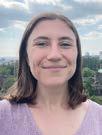
Carolena Muno ’23, an anthropology major and health studies minor, will join Sidney Kimmel Medical College’s population health track this fall. She points to her experience in 2020 as a summer assistant at the Seattle Indian Health Board for inspiring her to pursue that path. At the height of the COVID-19 pandemic, Muno says, she witnessed a parallel crisis among the young people she was working with who were victims of violence in their homes and communities. Beyond lasting barriers to emergency treatment, she says, most also lacked access to violence prevention and recovery resources.
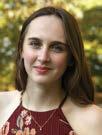
arlier this fall, Derek Zhang ’26 was looking for a platform to exercise both his affinity for speaking in front of a crowd and the cross-disciplinary exchange of ideas that courses through Haverford’s educational mission. He found one in TEDx, the smaller, community-focused program of TED (Technology, Entertainment, and Design), the nonprofit devoted to “ideas worth spreading” and best known for its engaging TED Talks.
Zhang found a likeminded partner in Nimisha Ladva, a visiting assistant professor of writing, and the duo spent months navigating logistical challenges, booking speakers, creating workshops, and staging rehearsals to bring TEDx to Haverford on April 27. It was the second time in the College’s history hosting such an event, which last occurred in 2012.
For Zhang, hosting TEDx at Haverford was about much more than public speaking. Since arriving at the College, he says, he’s been keenly interested in learning about what subjects and ideas his peers are exploring. The rigors of being a student-athlete—Zhang is a member of the men’s soccer team— don’t always leave time to engage with peers outside of his discipline, he says, and TEDx seemed like the perfect remedy.
“I’ve learned about a lot of really interesting ideas just from my teammates. One of my best friends on the team wants to pursue space medicine research and become an astronaut,
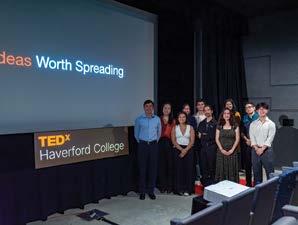
which is so cool,” Zhang says. “If those are the kinds of ideas coming from the 30 athletes on the team, I was really curious to find out what else is in the 1,500 bright minds here.”
Ladva and Zhang, a neuroscience major, had never met on campus until the student “cold-called” the professor via email. “Just like any good entrepreneurial student would do,” Ladva says. The professor helped arrange funding through the Mark and Lillian Shapiro Speaking Initiative, with additional support provided by the offices of Institutional Advancement and Student Life.
“We didn’t know each other at all. Total strangers,” says Ladva, a specialist in public speaking and oral communication. “But I have an interest in building community and Derek does, too. So we immediately saw the opportunity with TEDx as a way to build a conversation across groups that don’t ordinarily get a chance to talk to each other.”
The pair quickly formed a strong working relationship as they navigated a long list of TED’s procedural hurdles— onboarding webinars, audience limits, videography requirements, catering—throughout the year. For additional help, they turned to Zhang’s classmates Kabir Hinduja-Obregon ’26 and Shir Toledo ’26. Hinduja-Obregon, a former student of Ladva’s who joined the team in December, helped design the event, interviewed potential speakers, and prepared those who were selected for the event. Toledo joined later to serve as a creative director, handling the design of the event’s flyers and programs while providing additional logistical support.
After considering more than 25 speaker applications from across campus, the team shaped a program of six speakers, a group comprising five students and one staff member. Selected talks ranged from insights for more livable main streets to secrets for a happier mind, engaging topics that drew a sellout crowd to Visual Culture, Arts, and Media (VCAM) facility’s screening room.
Winnowing the list was a challenging endeavor, Ladva says. “It was important to highlight what our applicants were bringing to the pool rather than finding a way to exclude people. That was never our intention,” she says. “We wanted to have a full range of STEM, non-STEM, humanities, and arts [subjects]. That was our goal.”
Ladva says the event fostered leadership development for all members of the team, especially when it came to dealing with setbacks. Unfortunately for Zhang, his name was not listed among the event’s speakers. It wasn’t until late in the process that he learned TEDx organizers are not allowed to give a talk at their event. Instead, he settled for the role of co-emcee alongside Hinduja-Obregon.
—Dominic Mercier
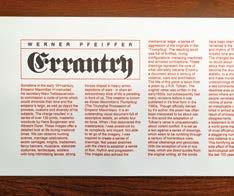

Spotlighting the holdings of Quaker and Special Collections IN THE COLLECTION
VWerner Pfeiffer’s Errantry is a 27-foot scroll stored in a deactivated World War II era howitzer shell casing.

iewing Werner Pfeiffer’s 2008 piece, Errantry, involves removing the digitally printed canvas scroll from a deactivated World War II era 105mm howitzer shell casing— which is all part of experiencing the artwork. The 27-foot scroll features a mix of text and imagery that tells a story of war and conflict in the 20th century.
Pfeiffer, an American born in Germany, created the piece as a response to a century of global conflict. Errantry stitches together the artist’s drawings and elements from the J.R.R. Tolkien poem of the same name. Though the celebrated professor and author of The Hobbit and the Lord of the Rings trilogy officially denied it, his 1933 “Errantry” has long been viewed as a piece of anti-war literature drawn from his service as a British Army soldier in the trenches of World War I.
Pfeiffer’s message is much more clear. Besides a few lines, the artist changed nearly all the original poem’s words while maintaining Tolkien’s distinct meter. The updated language is an unequivocal criticism of war and provides, as Pfieffer says, “the drumbeat to a terrifying statistic, to a chronology of death and
mass murder, one of the darkest underpinnings of the 20th century.”
The work was inspired by Triumphzug Kaiser Maximilians, a set of more than 130 masterful woodcut prints by artists including Hans Burgkmair and Albrecht Dürer that was commissioned in the 16th century to commemorate the reign of Holy Roman Emperor Maximilian I. When viewed as a whole, the prints provide an unparalleled look at medieval life as knights, tradespeople, and exotic carriages form a vibrant and artistically significant parade.
“One of the dominant features in this document is the militant nature of many of the characters depicted, as well as their posture in parading their arms on horse, by carriage, or on foot,” Pfeiffer says of Triumphzug Kaiser Maximilians . Though much shorter than the 170-foot-long compilation it references, Pfeiffer’s scroll, which includes a four-column introduction, is no less significant.
He created only 52 copies, each stored in a different type of shell casing. Haverford acquired the 31st copy of Errantry directly from the artist in 2009. As noted on a label on the wooden case, the shell is completely inert, its powder and fuse spent while serving its deadly purpose.
—Dominic Mercier
Course title: “Electronic Music Evolution: From Foundational Basics to Sonic Horizons”
Taught by: Assistant Professor of Music Mei-ling Lee
What Lee has to say about the course: Many people think of electronic music solely as dance music, characterized by synthesized sounds and fast-paced drum beats. As this course demonstrates, however, electronic music encompasses much more.
Electronic music, an ever-evolving and dynamic entity, has not only significantly influenced the contemporary sonic landscape, but has also ushered in a revolution in how we create and experience music. My goal was to create a class that provides students with a comprehensive understanding of the diverse landscape of electronic music, including the history of the genre, the physics of sound and recording, and experience creating it themselves.
In this course, we embark on a journey from electronic music’s inception with the Telharmonium (an electric organ also called a Dynamophone that was created in the late 19th century) to its present-day manifestations, featuring interactive live performances driven by cutting-edge technologies. Delving into our musical past allows us to understand our identity, our progression, and the evolution of music-making to its present state. Having gained insights from our historical journey, it’s essential to look forward. What defines contemporary music? What constitutes “our” music today? This course explores those questions,
and helps students cultivate essential critical listening skills, vital for both music creation and analysis.
An essential aspect of this course involves the hands-on use of state-of-the-art electronic music production tools, software, and technologies. Students enrolled in the class will have access to the electronic music studio, where they can explore the practice of electronic composition and performance while gaining insights into the theories and emerging directions of electronic music.
Cool Classes is a recurring series on the Haverblog. For more, go to hav.to/coolclasses.
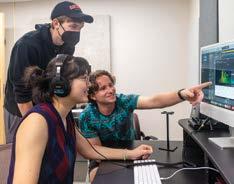
“ Knowing some of the extreme scenarios Earth has faced can help people understand the urgency of our current problem. The last time we think carbon dioxide was 600 parts per million, which is not an unreasonable projection for the end of the 21st century, we had reptiles up in the Arctic Circle. That’s a very different world than the one humanity has become used to. Unless we want to live in that world, we really need to take steps to address it now. ”
PROFESSOR OF ENVIRONMENTAL STUDIES JONATHAN WILSON received a multi-year grant from the National Science Foundation to study ancient plants during periods of extreme warming and atmospheric carbon dioxide in Earth’s history. What he and his colleagues uncover could tell us what to expect if climate change is left unchecked.
STAY CONNECTED TO THE LATEST HAVERFORD NEWS





facebook.com/haverfordcollege @haverfordedu @haverfordedu @haverford.edu @haverfordedu
averford has a lot of longstanding traditions to mark important milestones in student life, as the scores of signatures left by graduating seniors adorning the cupola and bell atop Founders Hall can attest. But in 2016, when sophomore Kevin Liao ’18 was ready to declare his major, he felt something was missing.
HAs he prepared to formalize his choice, his friends at other liberal arts colleges reported much more pomp and circumstance surrounding that important moment. Many, he says, had fair-style setups and other celebrations where students are given gifts or a small bottle of something bubbly to mark the occasion.
“I had the idea that Haverford would do the same thing,” Liao recalls. “But when it actually came time to declare my major, I found the process deeply unsatisfying. You just showed up to the registrar’s office, filled out a form, and that was it.”
After watching President Obama’s January 2016 State of the Union address, Liao formulated a plan. He says he found inspiration in the sergeant-at-arms’ booming, authoritative announcement of the president’s entrance and landed on a way to upend the practical nature of Haverford’s declaration process.
“I thought, all right, now that’s a way to declare something,” says Liao, who is now a software engineer. With a friend in tow to capture the moment on video, Liao marched into the registrar’s office and loudly declared, “Mr. Registrar, I intend to declare a major in computer science and linguistics,” before making an abrupt about-face and leaving.
As he departed, an unseen voice jokingly replied, “Are you sure?” That belonged to James Keane, the College’s registrar and executive director of academic assessment and operations. Three years ago, Keane recalled Liao’s announcement as he and other staff members were brainstorming new ways to stave off the dreaded sophomore slump and enhance the student experience at Haverford. In that Zoom call, Keane says, Director of Student Engagement and New Student Programs Jodi Mulhall reminded the team that college traditions should be fun, even quirky.
“That was particularly resonant, and reminded me of when Kevin ran into the office to declare his major. Everyone got a kick out of that,” Keane says. “I thought maybe we could turn that into something where students
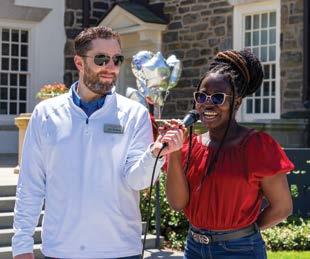
could recreate that moment and we can celebrate it.”
For the past three years, Haverford sophomores have been invited each spring to step up to a microphone outside the Visual Culture, Arts, and Media (VCAM) facility to scream their chosen major for all to hear. Each declaration is greeted with a chorus of ringing miniature cowbells—a precursor to ringing the bell in Founders Hall just before Commencement—and one of Keane’s groan-worthy dad jokes. “If someone declares geology, I’ll say, ‘Geology rocks! But geography is where it’s at,’” he says. “I get a lot of eye rolling from my wife at home.”
It seems everyone was in on the joke but Liao, who had no idea the College had begun a new tradition based on his bold declaration. He only found out when scrolling through social media one afternoon in late April, when he stumbled across a recap video of the 2023 event shared through the College’s Instagram account. In it, Keane recounted the event’s origin story and Liao realized he had inspired a new addition to Haverford’s long list of traditions.
“OH MY GOD THIS WAS ME,” wrote Liao in the comments, in a manner befitting his earlier declaration. “I can’t believe this is a whole ceremony.”
— Dominic Mercier
For two years, students at Haverford and the American University of Sharjah worked together online to study human rights. This spring break, they met in person.
Despite 7,000 miles, the vast Atlantic Ocean, a sea, and a gulf separating them, Haverford faculty and students have been collaborating with counterparts at the American University of Sharjah (AUS) in the United Arab Emirates (UAE) for the past two years. Using technologies like Zoom to bridge the distance, the virtual exchange, funded by a Stevens Initiative grant, has allowed both contingents to grapple with issues like the implementation of the United Nations’ Sustainable Development Goals and human rights at home and abroad.
Over spring break, students, faculty, and staff built upon these


virtual relationships through a travel experience funded by The Robert W. 1965 and Vivian S. Toan Fund for Engagement with Humanitarian and Middle East Issues. A delegation of 10 Haverford students, led by Executive Director of the Center for Peace and Global Citizenship (CPGC) Eric Hartman and Assistant Professor of Economics Shannon Mudd, packed their bags for a flight to Dubai.
Across their seven-day whirlwind tour of the elective monarchy, they visited their peers at AUS and toured innovative NGOs, tech-forward companies, and numerous important cultural sites, like the House of Wisdom, a beautiful library modeled on the 8th-century library of the same name in Baghdad.
Students were eligible to go on the trip if they had participated in the virtual exchange with AUS or CPGC-funded humanitarian engagement opportunities in the Middle East. “Participants were incredibly diverse and from a range of disciplines, a really wonderful cross-section of the College community,” Hartman says. “They came from across the U.S., Bangladesh, Egypt, and Pakistan, which really added to the discourse throughout the trip.”
Several of the students who participated are Muslim, and the trip to a predominantly Muslim country took place during Ramadan, a month-long holy celebration that requires participants to fast from sun up to sun down. Mudd, Hartman, and both Muslim and non-Muslim students opted to join in the observance. A highlight, Mudd says, was the daily communal breaking of the fast, especially one evening with 1,000 others in the lush gardens of Abu Dhabi’s Sheikh Zayed Grand Mosque.
“It was the most amazing experience of hospitality and community, and it meshed so well with what students had said about why they found Ramadan such an important month,” says Mudd. “Oftentimes, they spoke about community and the breaking of the fast. My experience of this at the Grand Mosque was unforgettable and inspiring.”
Students agreed that the trip offered a lot of value beyond what they had been taught in the classroom. Rafael Montero ’24, an anthropology major who is now beginning policy-focused opportunities in Washington, D.C., through the Truman Fellowship, says his experience in the UAE, where nearly 90 percent of the population are immigrant workers, reaffirmed critical elements of what he learned in his studies at the College.
“Historically, anthropology has often boxed people into a certain culture and framed a certain image of them,” Montero says. “But anthropology at Haverford is very different from that. We’re focused on inequalities and how power inequities affect people differently, especially the marginalized. That was a big takeaway for me.”
—Dominic Mercier
The
on

and the
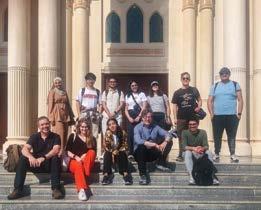
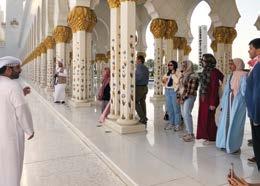
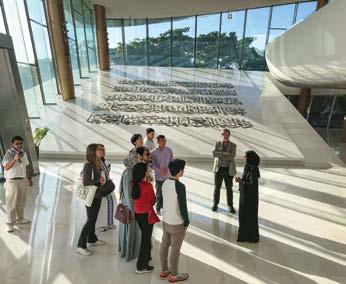
A digitization project reveals the hidden history of Quaker-run Native American boarding schools.
Two images, captured just three years apart, reveal Tom Torlino’s staggering transformation.
The side-by-side images of Torlino, a member of the Navajo Nation who entered the Carlisle Indian Industrial School near Harrisburg, Pa., have proliferated across the internet as the country has begun to grapple with a period of its history in which the federal government brandished education as a weapon in an attempt to “kill the Indian in him, and save the man,” as Richard Henry Pratt, Carlisle’s founder and longtime superintendent, declared in 1892.
The images of Torlino’s transformation are emblematic of the assimilation goals established by officials and faith groups, including Quakers, who operated more than 500 schools across the nation at the turn of the 19th century, but fail to fully convey the cruelty and rampant abuse that tens of thousands of young Native Americans were forced to endure, which in some cases, resulted in their deaths.
Now a new effort, supported by a $124,000 grant from the National Historical Publications and Records Commission, is shedding light on Quaker involvement in the boarding school era by digitizing more than 20,000 documents contained within the collections of Haverford and Swarthmore Colleges. The project is a collaboration between both colleges and the National Native American Boarding School Healing Coalition (NABS), a nonprofit formed in June 2012 to address the lingering trauma caused by the nation’s boarding school policies. It aims to bolster a publicly available digital archive that NABS launched April 30.
“When [NABS] started, we knew that there was primary source documentation out there that is easily reachable, like at the National Archives and Records Administration. The material there is all public record,” says Stephen R. Curley, NABS’ director of digital archives. “But then on the other side of the coin, there are all sorts of private collections and academic libraries with collections the public just doesn’t know about.”
NABS’ work to create an accessible online archive of documents detailing the operations of North America’s boarding schools intensified, Curley says, when worldwide news broke in 2021 about the discovery of the remains of 215 children on the site of the Kamloops Indian Residential School in British

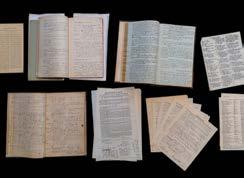
Columbia, the largest in Canada’s boarding school system.
As they sought documents from religious groups to bolster NABS’ archive, Curley and his colleague Samuel Torres, the organization’s deputy chief executive officer, turned to Quaker historian and former Haverford Friend in Residence Paula Palmer in order to learn more about Quakers’ involvement in American boarding schools. Quakers, Curley says, significantly influenced President Ulysses S. Grant’s Peace Policy, the misguided legislation that gave rise to the boarding schools. But records of their operations are scattered and less well-known, leaving them understudied.
“As you can imagine, boarding school-relevant records exist in various locations and repository contexts throughout the U.S. The nature of surveying where material might exist can be very chaotic,” Curley says. Most, he adds, are available through federal resources, like the National Archives, or through churches. “Beyond that, the runner-up is academic institutions like Haverford and Swarthmore that steward manuscripts of schooling institutions that were oriented towards a larger missionizing project.”
Sarah Horowitz, Haverford’s curator of rare books and manuscripts and director of the library’s Quaker and Special Collections, notes that Haverford and Swarthmore are well-positioned to provide critical insight into the operations and legacy of nine Quaker-run schools in Indiana, Kansas, Nebraska, New York, Ohio, Oklahoma, and Pennsylvania,
thanks to documents sent to the Philadelphia Yearly Meeting by local Quakers. These include a wide array of reports, journals, photographs, and other administrative and financial records. While they have been studied by both scholars and those interested in writing about Native American history, this is the first time they’ll be digitally accessible to the broader public.
“We take access very seriously, and having a digitization strategy is part of that,” Horowitz says.
In March, she and the libraries welcomed Curley and a three-person scanning team that NABS hired through the grant to process the documents. The efficient operation, Curley says, yielded scans of 22,221 documents that are now being cataloged and prepared for upload into NABS’ digital archive. Curley says he expects the Haverford and Swarthmore documents to be available in late 2024 and is considering pursuing additional grant funding that will enable even more documents to be processed.
Tsinni Russell, an archival assistant at the Denver Public Library and a graduate student at the University of Alabama, traveled to Pennsylvania as a member of the scanning team. Like many Native people, the process was intensely personal for Russell, who is Navajo and has relatives who attended boarding schools. Over the four weeks he was present on both college campuses, Russell spent nearly eight hours each day loading books, documents, and photographs onto an overhead scanner.
“What sticks out to me about these materials—and the boarding schools, in general—is just how bureaucratic and thought-out everything was. It’s distressing to read,” Russell says. “It wasn’t all new to me because I had been studying and researching [boarding schools], but still, every now and then it just hit me. I had to take a walk for 10 or 15 minutes to just clear my head before getting back to it.”
Despite the difficulties inherent in the scanned material, the team’s necessary work represents a significant contribution to NABS’ larger effort to connect these records with living boarding school survivors and their families. Ultimately, Curley notes, the partnership between his organization and the colleges is a necessary model he hopes can be replicated elsewhere as NABS continues to uncover the truth about the boarding schools.
“I was particularly excited to work with NABS on this project because they bring both a lived experience and an expertise to this work that we at Haverford can’t,” says Horowitz. “It’s really important to have them lead these types of projects so that we can make these documents available with the appropriate context and in conversation with materials from other religious groups and government agencies that were also running these horrible boarding schools.”
—Dominic Mercier
WHAT: The Haverford Ornithological Club offers students an opportunity to connect with nature and fellow bird enthusiasts. While birdwatching is the club’s core activity, with weekly walks around campus, members also delve into bird biology, photography, ethics, conservation, and more. The club also occasionally partners with other campus groups like the Haverford Outdoors Club and has hosted guest speakers, including birder and Professor of Environmental Studies Jonathan Wilson.
WHERE: Meetings typically start near the Whitehead Campus Center and follow a path through the Nature Trail, a roughly hour-long loop. “Haverford’s campus is perfect for nature and bird lovers,” says Ashrith Kandula ’26, the club's incoming co-president with Nadav Gilad-Muth ’27, a prospective environmental studies major. “We see around 20 different species each meeting, with the meadow by the Duck Pond being particularly productive.” Next year, the club plans trips off-campus to prime birding locations like John Heinz National Wildlife Refuge at Tinicum, Hawk Mountain, or even nearby Bryn Mawr College.
WHY: The pandemic reignited people’s appreciation for the outdoors and birdwatching, says Kandula, a birder for more than a decade. Pennsylvania’s unique location on the migratory path of many birds is ideal for spotting diverse species. The club has seen bald eagles, belted kingfishers, broad-winged hawks, pileated woodpeckers, and a variety of warblers, a club favorite. Roughly 30 different species of these small, colorful birds migrate through the area, and on a series of spring walks Kandula dubbed “Warbler Bonanzas,” the group spotted half that number. “It’s a fun way to take a break from studying and get some exercise,” says Kandula, a neuroscience major with a chemistry minor.
WHO: More than 60 members receive the club’s emails, which recap hikes and include bird photos and facts. The number of attendees at weekly meetings fluctuates. New members are welcome.
WHEN: The club is active throughout the year. “Every month offers something unique in birding,” says Kandula. “Spring migration, from late April to early May, is simply incredible. You just want to be outside all the time.” He continues, “But winter birding is more enjoyable than you might think. We see some really cool ducks that breed in Canada and migrate south for the winter, like buffleheads. There’s always something interesting to see.”
— Jill Waldbieser
A Canada warbler spotted on one of the club’s spring “Warbler Bonanza” walks.

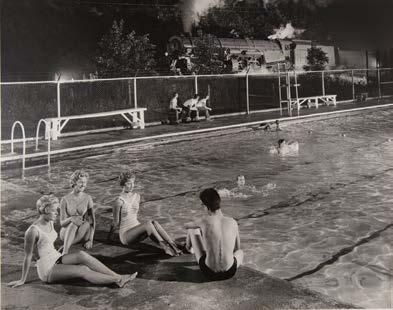
Through Dec. 7 in the Jane Lutnick Fine Arts Center, Atrium Gallery
A collection of 34 black-and-white photographs taken by O. Winston Link (1914–2001) captures the late history of steam locomotion along the Norfolk and Western Railway, one of the nation’s last major railroads to make the switch from steam to diesel power. The photographs, taken between 1955 and 1960, were a gift to the College by Tom Garver ’56, an ardent supporter of both Link and his alma mater.
Garver, who died in June 2023 at age 89, was an accomplished museum administrator, serving as founding director of what is now California’s Orange County Museum of Art and the director of the Madison Museum of Contemporary Art, among other positions. He met Link, who had also been hired to create admission brochure photographs for the College, in 1952 and later worked as the photographer’s assistant for nearly a year. In that role, Garver accompanied Link on three trips to support his
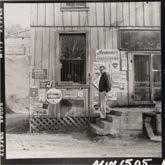
documentation of the dwindling age of steam-powered railroading. Following Link’s death, Garver became the organizing curator of the O. Winston Link Museum in Roanoke, Va., and authored The Last Steam Railroad in North America, the definitive publication on Link and his photography. Through his efforts, Garver helped establish Link as a celebrated 20th-century photographer whose work deftly probes the juxtaposition of railroads and rural culture.
The exhibition, which also includes several of Link’s promotional photographs for Haverford, is a fitting tribute to a devoted friend and alum.
The exhibit captures the late history of steam locomotives in photos like Swimming pool, Welch, West Virginia, ABOVE. The collection includes this portrait, Tom Garver at the General Store, Husk (Nella), North Carolina, 1957, LEFT, of the alumnus who donated the collection.
In April, the College hosted its most successful Open Campus Day to date. The annual event, which draws admitted students to campus where they receive a taste of what Haverford has to offer, welcomed 275 potential Fords and their families for a weekend of tours, panels, an academic fair in Alumni Fieldhouse, and much more. More than two dozen current students, clad in bright red “Welcome, Friends” T-shirts, were also on hand to answer questions about academic and social life at the College.






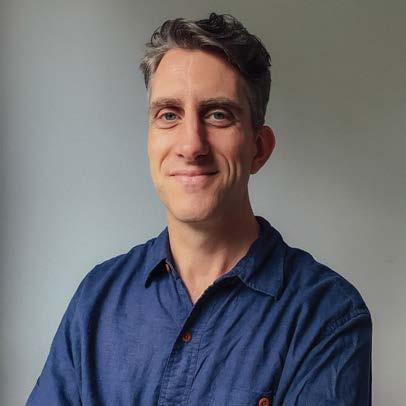
Jonathan Miller ’01 scored an Emmy for his work on the baseball documentary The Last Out BY
PATRICK RAPA
hen making a documentary, the shoots can feel like a sprint, but the overall process is a marathon. That was certainly the case for producer Jonathan Miller ’01 and the rest of the filmmakers behind The Last Out. Their flyon-the-wall documentary about Cuban baseball
Wplayers scored an Emmy eight years after they started working on it.
Miller was brought to the project by Sami Khan, his colleague from the New York City film world, and they partnered on it. Miller was a natural choice, as he’d filmed in Cuba before, and was a big sports fan. “I was working on a lot
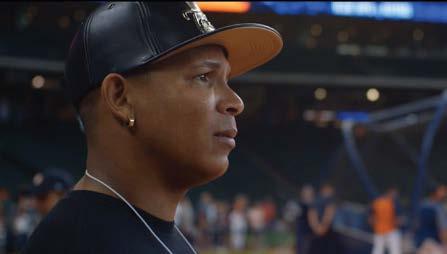
of TV docs between narrative film projects at that time, and I figured why not work on a doc project I actually cared about and had a real say in,” he recalls.
Initially, the idea was that the film would focus on Yasiel Puig and other well-known Cuban players who’d made it in Major League Baseball (MLB). “It changed a lot as we shot exploratory interviews and stumbled onto the guys that would be in the film,” Miller says. Their new subjects—Victor Baró, Carlos O. González, and Happy Oliveros—were young and naïve, but also talented and ready to defect for a chance at making the big time.
The journey was at times difficult and dangerous, and the players were often stuck in limbo as they waited long stretches between tryouts in front of MLB scouts. All three were crammed into a small house in San José, Costa Rica, where they slept, cooked, and worked out.
“We rode that roller coaster with them, from multi-million dollar expectations to much later, just wanting them to accept a deal that would give them a decent shot,” Miller recalls. In all, the crew made 16 trips to Costa Rica, returning home to work other jobs and search for funding to keep the project going.
Once shooting wrapped in 2018, the film entered a limbo period of its own, with the lengthy editing process—they’d shot around 400 hours of film—and the COVID-19 pandemic keeping The Last Out from audiences until 2022. A deal with the POV series on PBS finally landed the documentary on TVs (and in theaters and on

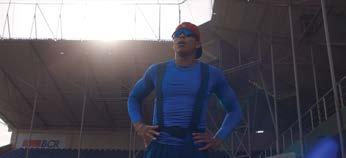
airplanes) later that year, and led directly to that surprise Emmy win in 2023.
“I sort of didn’t realize how big it was, winning an Emmy, until it happened,” says Miller. “And I think it helps with future projects.”
Miller, who majored in comparative literature and Italian at Haverford, has a diverse CV. He’s worked on SXSW Grand Jury Prize Winner Gimme The Loot, comedies like Desus and Mero for Showtime, the second Borat film, science and climate change documentaries for National Geographic and HBO, as well as an upcoming documentary on the artist KAWS and a basketball series for Netflix. But shooting a passion project like The Last Out offered interesting opportunities for him as a cinematographer.
“Smaller crews are more flexible and more nimble,” he says. “It’s a more intimate experience, and I think we are always trying to re-create that in various ways with bigger productions to get better, more vulnerable performances.”
For the
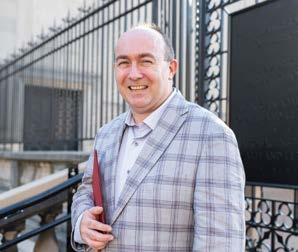
A700-plus-page nonfiction book with 250 pages of notes and citations, no central plot, and hundreds of separate, reported stories and interviews seems unlikely source material for an award-winning musical theater production. Yet that’s exactly what won Justin Warner ’93 and his partners the 2024 Richard Rodgers Award for Musical Theater from the American Academy of Arts and Letters.
Far From the Tree, a musical that follows several stories of parents raising profoundly different children, “explores what happens when the self your child inhabits is—at least at first—beyond your recognition or understanding,” says Warner. It is a subject he and his partners, Robert Maggio, who wrote the show’s music, and lyricist Kristin Maloney, are all intimately familiar with as parents themselves.
“It’s a great honor and legitimization of our work,” Warner says of receiving the award, which provides funding for a developmental workshop at a nonprofit theater in New York to further cultivate the show.
While Far From The Tree has had multiple workshops and readings over the years, including at New York’s prestigious Public Theater, Warner says, “This is an important new milestone. It’s a significant honor for a musical in development, and one that will hopefully help us attract new attention.”
The musical, which has been in development for more than a decade—including some downtime during the COVID-19 pandemic—is based on the 2012 New York Times bestseller Far From The Tree: Parents, Children, and the Search for Identity by Andrew Solomon, which explores how parents
adapt to children very unlike themselves, including those with deafness, dwarfism, schizophrenia, and physical disabilities as well as transgender children and child prodigies. To convert the somewhat weighty book into a musical, the show focuses on three of the many family stories depicted in the book and on Solomon’s own experience as a parent.
More broadly, however, Warner says the musical taps into the universality of the parenting experience. As any parent finds out, he says, “You’re in control of very little, you have to meet the kid where they are, and figure out who they are.”
At Haverford College, Warner majored in psychology with a concentration in neural and behavioral science. But he also had a strong interest in musical theater, performing in shows including Pippin and Little Shop of Horrors as part of what was then Haverford’s Broadway South theater troupe.
His first job after graduation was as a writer for the American Association for the Advancement of Science (AAAS). At AAAS, he later served as writer and script editor for the children’s science/mystery/adventure show Kinetic City Super Crew, which won a Peabody Award in 1996. Deciding to pursue his interest in theater professionally, he went on to earn a master of fine arts in playwriting from the Catholic University of America.
Since then, he has had numerous plays produced in the United States and abroad, including American Whup-Ass at the AlterTheater in the San Francisco Bay Area, and Imposters at London’s Union Theatre. Warner, who has lived in New York for more than 20 years, balances his playwriting time with his position as a clinical associate professor of expository writing at New York University.
The Richard Rodgers Award was endowed in 1978 by the composer (half the duo of Rodgers and Hammerstein) to nurture talented composers and playwrights. Rodgers’ works include The Sound of Music and Oklahoma! Past award recipients include Jonathan Larson for Rent and Anaïs Mitchell for Hadestown, shows that went on to become Broadway hits.
Warner says he is grateful for the opportunity the award provides to further refine and develop the show through workshops with talented actors and directors. After 10 years of work on the musical and with the boost of the Rodgers award, his primary goal is to see Far From The Tree produced on stage “at a really high level of excellence and to find an audience.”
And while that audience will likely include people who have some of the same issues as those depicted in the play, Warner expects the show to resonate with a broader public who feel empathy for the characters portrayed. “The show is for anyone who’s been a parent, which is a lot of people, or anyone who’s been a child, which is everybody,” he says. “It’s about having a better understanding of what it’s like to raise kids.”
—Debbie Goldberg
Immense in its size and power, the Mississippi River snakes from Minnesota to the Gulf of Mexico and is fed by more than 100,000 named waterways, draining a watershed of more than one million square miles. Almost as enormous is the human effort over the centuries to control the unruly river with an endless, costly procession of dikes, canals, channels, dams, and levees—including one wall of earth that now stretches 380 unbroken miles and stands as tall as 40 feet.
In his new book, The Great River: The Making and Unmaking of the Mississippi (W.W. Norton), Boyce Upholt ’06 offers both a natural history of the famous waterway and the endless efforts to “fix the river,” a charge led by a changing parade of poli-ticians and camps of engineers who, Upholt writes, “squabbled about science and theory and who should be in charge.”
“Improving” the river would entail the clearance of its original inhabitants, the Native American tribes who built many large, walled cities along the Mississippi, including one (c.1050) that featured 120 pyramids. The relentless engineering efforts would also bring a cascade of other consequences, including record flooding and the destruction of wetlands that once protected inland towns. “The river we have built is coming apart,” Upholt writes.
Upholt, who wrote about the particularly revealing canoe trip that inspired The Great River for this magazine [Fall 2019], is a freelance journalist whose work has appeared in The Atlantic, National Geographic, the Oxford American, and Virginia Quarterly Review, among other publications. He also publishes Southlands, a Substack newsletter he describes as “a field guide to living amid Southern nature.” A native of Connecticut, Upholt lived in the Mississippi Delta for nine years before moving to New Orleans in 2018, where he and his wife recently bought a house. He spoke to Haverford magazine writer Eils Lotozo about his new book.
Eils Lotozo: You earned an MFA in fiction writing at Warren Wilson College, but you’ve built a career as a writer in nonfiction. How did that come about?
Boyce Upholt: My dream was always: “I’m going to grow up and write novels and short stories.” But I just didn’t know how to do it. After Haverford, I wound up working for Teach for America in South Dakota and then in the Mississippi Delta.

I think throwing myself into places that had such severe economic and social challenges made me read more nonfiction, which increased my interest in it.
I was an English major at Haverford and my thesis was about the setting of The Great Gatsby. I’ve always been interested in ideas of place, and as I became a nonfiction writer, I think that transferred over to wanting to understand the places where I’ve lived.
I started out writing little essays about life in Mississippi. Then, while I was getting my MFA, my freelance magazine writing career started to take off. I’ve found I really love the process of nonfiction storytelling. I love going out and collecting information, and then it’s like dumping a bunch of puzzle pieces out on the table. There are infinite ways you can arrange them, but how do you package [a story] in a way that will be engaging for readers?

EL: You did an enormous amount of research for the book. Did you realize how deep you’d have to go when you began?
BU: I’ve told people, when I sold this book, I was surprised that there wasn’t something like it—a book for a popular audience about the social and environmental history of the river—given its outsized place in our culture. What I realized was that’s because only a first-time author would conceive of a book like this. It didn’t occur to me that I was going to have to give myself a nearly master’s level crash course in geology, archaeology, Colonial history, and all this stuff.
I sold the book just as the pandemic hit. That gave me a lot of time early on. I thought I’d be hitting the road right away, but instead, I spent a lot of time with library books.
I never took a history course at Haverford, I just wasn’t interested. But as I got into nonfiction writing, my interest in history hugely took off. I never cared about “great man” history—for me it’s always been about wanting to understand
continued from page 25
the piece of ground I’m standing on. But eventually, I learned that to get to that you really do have to go back and understand all these other pieces.
EL: You have described yourself as a “nature critic.” What do you mean by that?
BU: I love reading good film, art, and music criticism that uses a text to explore history and what’s going on in our culture. And I’m interested in [the question of] when we look at nature, what is that telling us about how we conceive of the world and how our society functions?
Also, I’m literally critical of the idea of nature as it’s typically defined in Western society as anything that is not human. I think that a lot of the problems we face now—climate change, most prominently—can be traced back to the idea that we could somehow be separate from nature. Instead of “nature,” some philosophers use the phrase “the more-than-human world,” and I find that a lot more valuable.
EL: You write that the Mississippi has been called “an unappeasable god,” and that we might need to acknowledge its “right to build a landscape and then erase it again.” Is that even possible at this point?
BU: The Army Corps of Engineers now has a concept of “designing with nature,” and I mention in the book that some mayors of riverside towns are realizing that land they might

HILARY LEICHTER ’07: Terrace Story (HarperCollins)
Based on a short story that won a National Magazine Award, this novel tells the Narnia-esque tale of new parents Annie and Edward, who discover an expansive terrace in the closet of their small apartment that magically only appears whenever their friend Stephanie visits. They unquestioningly accept and exploit the myste-
have wanted to see developed may instead need to connect with the river. I also wrote at length about the projects here in Louisiana where the levees are being torn open and water is being poured back out. But these are all pretty small steps compared to what the river used to do.
People have asked me, “What should we do now?” Well, the hard thing is, given all that we’ve done in the past, we can’t just set the river free completely. The work of stepping back from the world we have built to a world that more fully regards the river’s power and ecology is going to have to be slow and tenuous, because we’ve just gone so far from that.
EL: What do you hope readers will take away from The Great River?
BU: This whole project started with a canoe trip. I lived in Mississippi for six years before I really got to see the river. Where I used to live, the levee might be 12 miles from the river itself. So I hope the book pushes more people out there to see the river because I think that will be a first step towards supporting better policy for it.
I hope that it also prompts people to take a closer look at the watershed that they’re in and how it came to be. There’s a quiz that an academic developed to test how well you know your own place, and one of the key questions is, “When rain falls in your yard, do you know how it goes from there to the ocean?” I don’t think a lot of people do.
—Eils Lotozo
rious space, but slowly realize that it is changing them. An allegory of loss and grief, charmingly told, it is the second novel from the acclaimed author, who teaches at Columbia University and lives in Brooklyn, New York.
DAVID ALFF ’05: The Northeast Corridor: The Trains, the People, the History, the Region (University of Chicago Press)
Millions of people have ridden what is arguably the nation’s most famous railroad line, which covers the geographic area from Boston to Washington, D.C.. Far fewer are familiar with its complex

and fascinating route through history, which involves the likes of Frederick Douglas and President Joe Biden. Alff, an associate professor of English at the University at Buffalo College of Arts and Sciences, put together an entertaining and comprehensive account of the corridor and all the ways it shaped and was shaped by an industrially evolving America. It’s the perfect reading material for your next Amtrak trip.
ANDREW SHANKEN ’90 AND VALENTINA ROZAS-KRAUSE: Breaking the Bronze Ceiling: Women, Memory, and Public Space (Fordham University Press)

Public memorials have fallen under scrutiny in recent years, though not usually for their glaring omission of female figures, which this collection of essays artfully addresses. Included are stories that examine representations of figures including Helen Keller, Sojourner Truth, and New York’s Fearless Girl, as well as broader themes such as race and political repression. Shanken, a professor of architectural history and the director of American studies at the University of California, Berkeley, and his co-editor have assembled an insightful set of stories to shine a light on women’s underrepresentation in public art.

EMMA COPLEY EISENBERG ’09: Housemates (Penguin Random House)
When two women newly sharing a living space embark on a road trip through rural Pennsylvania, ostensibly to claim an inheritance from one’s former professor, the result is a celebration of youth, freedom, art, love, and queer life. Both artists in their own right, protagonists Leah and Bernie decide to use the journey as a chance to document American through their respective art, and end up discovering more about themselves and each other in the process. The novel is the second from Eisenberg, an award-winning queer writer based in Philadelphia.
CHARLES JOHANNINGSMEIER ’81 AND JESSICA E. MCCARTHY, EDITORS: Reimagining Realism: A New Anthology of Late Nineteenth- and Early Twentieth-Century American Short Fiction
(Ohio University Press)

Johanningsmeier, Isaacson Professor of English at the University of Nebraska at Omaha, has helped assemble a fresh look at the post-Civil War era in this collection of stories, which includes both less-celebrated authors and lesser-known works of greats including Louisa May Alcott. The result is a collection that crafts a much more nuanced look at American life and literature up until the end of World War I.
EVE GLEICHMAN ’11 AND LAURA BLACKETT: Trust and Safety (Penguin Random House)

uals flocked there. Wiencek deftly chronicles those changes and life in the boomtowns that arose through various lenses, including migrants, politicians, and one Black woman who stood to become the wealthiest oil heiress in America. The result is a compelling history that also offers a lot of insight into the state’s present-day dynamics.

SARAH-SOONLING BLACKBURN ’09: Exclusion and the Chinese American Story (Penguin Random House)

This smart satire for the Instagram age is set in the Hudson Valley, where a newlywed couple has attempted to purchase the “authentic life” they crave, only to discover a queer couple living it effortlessly. Obsession and jealousy ensue, creating a biting commentary on modern-day aspirations. This is the Brooklyn-based duo’s second novel.
HENRY ALEXANDER WIENCEK ’08: Oil Cities: The Making of North Louisiana’s Boomtowns, 1901–1930 (University of Texas Press)
The discovery of oil outside Shreveport, La., at the start of the 20th century radically transformed North Louisiana politically, racially, and culturally as corporations and individ-
Part of the Race to the Truth series for middle grade readers, this nonfiction book illuminates the pivotal role Chinese immigrants played in American history, which has for so long been overlooked in many textbooks. SoonLing Blackburn, who was born into a mixed-race Chinese Malaysian and American family, reveals the true story of the Chinese American experience from the gold rush to the present day, including the fact that some historians believe the first Chinese immigrants to America pre-dated Columbus by one thousand years. Revealing untold stories and shedding light on America’s treatment of immigrants, this history offers representation that has been missing for a truly inclusive history.
FORD AUTHORS: Do you have a new book you’d like to see included in More Alumni Titles? Please send all relevant information to hc-editor@haverford.edu
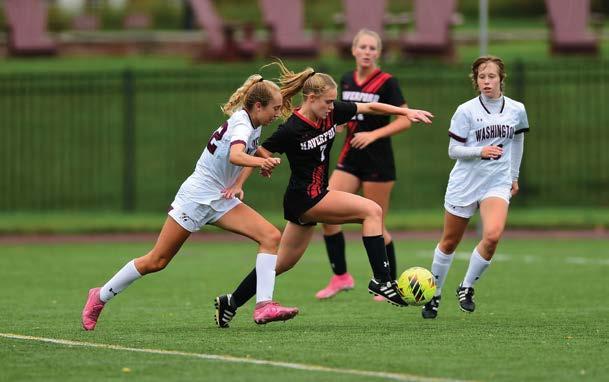
Olivia D’Aulerio ’26 broke a long-held Haverford track record, but maybe more impressive is that she did it in her offseason for soccer. Here’s how she juggles both. BY
CHARLES CURTIS ’04
ractices, meetings, team-building activities, and, of course, the games and meets themselves are enough to keep a student-athlete busy, at least until the offseason. But for students who participate in more than one sport, there is no offseason. When one sport ends, another begins, with a whole new training regimen and goals. Olivia D’Aulerio ’26 somehow makes this
Pbalancing act look easy. She’s a forward on the Haverford women’s soccer team in the fall and a sprinter in track and field in the winter and spring. What’s more, earlier this year, the New Jersey native broke the College’s record in the 400 meter, which has stood since 2011. D’Aulerio, a psychology major, manages to excel at both sports while balancing school work, extracurriculars, and a sophomore year that included
being a Residential Community Advisor (RCA) with first-year students as part of the Customs program.
D’Aulerio spoke to Haverford magazine about how she finds balance, the challenges she faces, and why she’s so passionate about staying in both sports.
Soccer was her first passion before she discovered a love of running: I started running track in high school as training for soccer. I was always told I was fast, and I thought maybe I’d be good at it because of my speed on the soccer field. But then I fell in love with track. I can’t say which sport I love more. Soccer is more fun, but in track and field, I get to see results more tangibly. I can see my hard work pay off in my improved times or by how much easier practices get.
The training for one sport doesn’t necessarily translate to the other:
In my freshman year, I finished my track season in the spring and the soccer team had a trip to Costa Rica in May of 2023. I got to play, but it was the first time I told my coach that I needed to sit out because I was out of shape. I had been focusing on my speed in track, but I realized how much endurance really matters for soccer. So I had all summer to get my endurance back into shape for the fall when soccer season began. In track, we focus more on technique and form rather than distance.
Juggling offseason team bonding and the sport that’s in season is a challenge: It was harder to balance everything in high school, where I’d go from track practice in high school to my house for dinner, then to club soccer at night. My approach at Haverford is to prioritize the sport that’s in season. During track season, there are offseason events the soccer team holds like meetings, team dinners, or our spring training program. I have to miss some of those because I have practice or need to do
my training. It’s all about communicating with my teammates so they know that my priority is whatever sport is in season. They understand and no one gets upset. But I also make sure to carve out time to have a separate dinner with them or to show support at an a cappella concert they’re singing in so I’m not isolating myself away from the team. Luckily, Haverford is a small school, so I’ll see my teammates around campus and in the Dining Center, which helps.
The key is focus: I’m a very determined person and I’m competitive, in general. You should see me on game night with my family. When I visited Haverford, I saw the indoor record for the 400 meter posted and I thought, “I can totally get there.” I was a few seconds away from it. Even though I had my doubts and might have felt out of shape at certain moments, I put in the hard effort in every workout and trusted my coaches and the training program, and I also trusted myself to give my all. I could see myself getting closer and closer to that record, which I tied at the conference meet. Then, at a meet at Tufts, I did it. My next goal is to break the outdoor 400 meter school record and to make it to the national championships.
Why not concentrate on one sport?
There’s a good reason for that: When I was younger, my mom and dad put me in some different sports, and I also acted in plays, learned the piano, and did Irish dance. I was able to do so many things and they were so much a part of my identity. I see myself as a soccer player, a runner, and a musician, and I’ve worked so hard to maintain those parts of myself that I really enjoy. Track and soccer feel like they give me my purpose. [They are] why I’m here at Haverford. I can’t stop now.
Charles Curtis ’04 is assistant managing editor for USA Today’s For the Win and an author of the Weirdo Academy series, published by Month9Books.
‘‘ I’M A VERY DETERMINED PERSON AND I’M COMPETITIVE, IN GENERAL. YOU SHOULD SEE ME ON GAME NIGHT WITH MY FAMILY. ’’
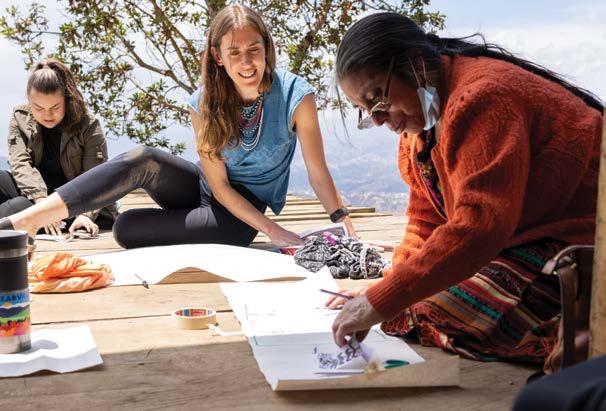
When Madeline Kreider Carlson ’10 first learned of the Watson Fellowship, she knew right away what she wanted to focus on for a year of international exploration: craft traditions and their role in knitting together community and opportunity between women.
The connection wasn’t new to Kreider Carlson, who grew up in a family of craftswomen. As a child, she volunteered alongside her mother and grandmother at local fair trade stores that sold handmade goods sourced from dozens of countries and artisan traditions. “I wandered the store in awe of the fact that every beautiful product was made by hand,” she says. “Those products represented so much tradition and skill, and so many different cul-
tures and design perspectives.” Kreider Carlson learned to cherish the subtle variations and imperfections that define a handmade item.
“My grandmother taught me how to sew and embroider—I’d go to her house and sew on a quilt in a frame,” says Kreider Carlson. “It was my first introduction to women crafting together, the communion around a project, and the conversations and connections that go with that. My mom is a crafter as well, it’s definitely part of our family tradition.”
Today, Kreider Carlson is executive director of Mayan Hands, a nonprofit, fair trade organization that coordinates with Maya craftswomen in Guatemala to sell their
goods online and in U.S.-based stores. She started the position in October 2022, after six years spent working in Haiti and Guatemala for several artisan organizations. Mayan Hands has two offices in Guatemala and a headquarters and warehouse in Albany, N.Y., where crafts are shipped each month.
Kreider Carlson, who is based in Minneapolis, visits Guatemala two to three times a year, spending a total of six to eight weeks there. “I collaborate with our team in Guatemala by WhatsApp and email almost daily,” she says. “A highlight of every trip is visiting artisans in their homes and communities, learning more about the intricacies of their craft process, and sharing home-cooked food.”
Kreider Carlson sat down with Haverford magazine to talk about her work for Mayan Hands.
Tell us about the concept of fair trade. What is it and why is it important?
It emerged as a response to the exploitation of global capitalism. It’s a structure for creating more than just economic relationships, based on a sense of mutual justice and appreciation. It gives craftspeople around the world access to markets. In its early years, it was very much a solidarity-based movement designed to open opportunities for farmers, artisans, and craftspeople, often from historically colonized countries, and giving them intentionally better pricing and pay to counter the market-determined price. It started in the late 1940s with goods that had been brought back by people doing international aid work.
Who does Mayan Hands serve? We serve 17 organized groups of Mayan women artists, about 185 artisans, all living in rural or semi-rural communities in the Guatemalan Highlands. We offer economic oppor-
‘‘
THOSE PRODUCTS REPRESENTED SO MUCH TRADITION AND SKILL, AND SO MANY DIFFERENT CULTURES AND DESIGN PERSPECTIVES.
’’
tunity through their artisan work. Many of these women are skilled craftspeople who learned from their mothers and grandmothers, and some of the organized groups are multigenerational. All of the women are indigenous and they speak four different Mayan languages. They work from home so they can sustain their other responsibilities while earning income. Each group has expertise in specific craft areas, such as embroidery, needle-felted animal figurines, or making pine needle baskets in a roster of designs. Many are not literate and don’t speak Spanish fluently.
The crafts represent a cross-section of traditional skill sets and introduced skills. The introduction of new craft techniques (by Mayan Hands) is in response to the saturation of the market. The work of these women is historically very undervalued and it takes a lot to get them paid fair wages for handwoven textiles. There’s a lot of competition and so many skilled weavers, so the idea was to expand opportunities by differentiating the products they’re making from other weavers.
What other programs does Mayan Hands offer?
Last year, we formalized a health and wellness program, in response to hearing about a lack of medical services for the women. It’s focused on
preventative healthcare, education, and mental health, which has been the most positively received so far. The majority of the women we work with are trauma survivors. A number of the artisan groups came together in the 1980s, [formed by] widows whose husbands had been killed by the military. We work with a Maya psychologist who provides group and individual therapy sessions.
We’ve also identified needs that are unmet by the government or community. Their top need is scholarship support for their children. Artisans are also eligible for scholarships, but it’s mostly helping their daughters defray the costs of education, such as uniforms, supplies, and fees. This year we have 49 scholarship students.
How did Haverford influence your career?
I was a history major with a concentration in Latin American history, and I also studied sculpture. I took a seminar on solidarity economics in the political science department, looking at alternative ways to structure economic relationships. I studied in Morocco and took a class on women and economic development, including a case study on craftswomen in rural Morocco. I was also granted a Center for Peace and Global Citizenship scholarship and went to Nicaragua, where I learned Spanish and worked with a women’s paper cooperative and recycling organization.
For my Watson Fellowship (“To Craft a Community: Women’s Craft Organizations and Sustainability”), I studied women’s craft organizations in Guatemala, Egypt, Uganda, Indonesia, and Mongolia. I sat on many concrete floors that year! It validated the idea that there is no one path in life. It showed me the worth of exploration itself.
To learn more about Mayan Hands, go to www.mayanhands.org
—Anne Stein
MICHAEL B. KIM ’85 P’17 FOUND SUCCESS IN DOING THE RIGHT THING. NOW, HIS GIFT TO THE COLLEGE WILL HELP OTHERS DO THE SAME.
By Lini S. Kadaba
SINCE HIS DAYS AT HAVERFORD COLLEGE, financier and philanthropist
Michael B. Kim ’85 P’17 has centered his way of life and work—as well as his best-selling novel Offerings—around the importance of making ethical choices.
In the 2020 book, soon to be a Hollywood movie, investment banker protagonist Dae Joon Shane Lee wrestles with closing a business deal for a friend that risks the livelihoods of factory workers. The fictional story closely parallels Kim’s own life, and the main character’s ultimate decision—spoiler alert—to do the right thing and support the workers over the business deal should come as no surprise.
After all, ethical inquiry has long been at the core of a Haverford education. It permeates classroom discussions, peer interactions, and the student-governed Honor Code. “It’s the inquiry that’s enriching,” says the English major and founder and chairman of MBK Partners, which manages more than $30 billion in capital. “Is this the right thing to do? Is this the right way to behave? Is the world going in the right direction? It’s a way of life for thinking Haverford students.”
Now, Kim is adding a big, bold exclamation point to the values-based framework of the College that he says has shaped who he is today. Kim, who was dubbed the godfather of
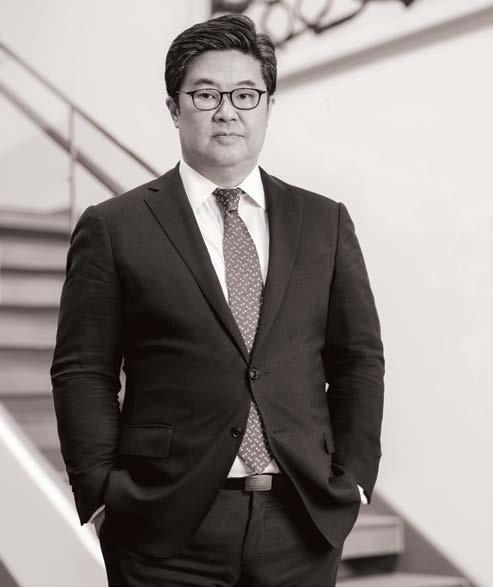
“ETHICS SUFFUSES EVERY PART OF SOCIETY, from politics to religion to our daily lives,” says Michael B. Kim ’85 P’17, whose gift will help establish a formal program for ethical leadership.
Asian private equity and one of the richest men in Korea, has pledged $25 million to help establish The Michael B. Kim Institute for Ethical Inquiry and Leadership and a new building to house it—boosting the cornerstone of the Haverford 2030 strategic plan. What he calls his “missive of gratitude” is equal to the largest donation in Haverford’s history, which came from alumnus Howard Lutnick ’83 to renovate the library.

The hope is that Kim’s pledge will elevate the profile of the school as a hub to explore ethics across the globe and develop principled leaders who want to not only make the world a better place, but also live out the College’s ethos of “trust, concern, and respect” in their daily actions. The incoming chair of Haverford’s Board of Managers, who makes his home in Seoul, says he envisions an interdisciplinary, cross-cultural approach, “producing and sending out ethics missionaries to the world.”
By focusing on the liberal arts, the initiative would have an especially Haverfordian hallmark, setting it apart from the many higher education ethics programs tied to business schools. “We’re actually doing liberal arts ethics,” says Jill Stauffer, a Haverford associate professor of peace, justice, and human rights who is co-leading planning for the institute with Sorelle Friedler, the Shibulal Family Computer Science Professor.
Exactly what that looks like, Stauffer says, is under construction. She, Friedler, and other Haverford entities are coming together to map out coursework, endowed faculty hires, building design, and co-curricular programming in stages over a five-year timeline, beginning in the coming academic year. Kim’s donation will serve as the lead gift toward the new building and programming.
“It won’t be, ‘How do I go into the business world and practice ethical decision-making?’” says Stauffer,
the author of the 2015 book Ethical Loneliness: The Injustice of Not Being Heard. “It will be more like, ‘How can I be an ethical person, practice ethics in the way I am with other people, and that ends up informing how I go out into the world and do whatever I end up doing?’”
In many ways, Haverford already does this work through academic concentrations such as peace, justice, and human rights, and any number of courses and extracurriculars, including Honor Council. Why a dedicated institute, then? “To make clear to the world, to the world of prospective students, to the world of prospective employers, to the world in general,” Haverford President Wendy Raymond says, “that if you care about how you live your life, this is a great place to come.”
In addition, the times seem ripe for focusing attention on ethical leadership. “Ethics suffuses every part of society, from politics to religion to our daily lives,” Kim says. “Leadership without ethics is a body without a soul. [There are] a lot of soulless leaders around the world these days.”
The institute would offer a new sequence of courses on ethical inquiry and leadership within the curriculum and support interdisciplinary research and endowed professorships and other faculty across departments. The College is also considering certificate programs in ethics. The building, significantly, will afford students physical spaces for exploration and collaboration—key to problem solving—as they develop a “toolbox of approaches to apply in specific situations,” Stauffer says.
“To be clear,” says Laura McGrane, who served as the College’s associate provost for strategic initiatives until July, “The institute is committed to ethics in action and working intensely with local and global community partners to learn more about how seeding ethical engagement and leadership can transform each of us and the worlds that we inhabit.”
The initiative, of course, would bolster would-be leaders; it’s right there in the name. But Stauffer, for
one, takes a more expansive view. “I want students to understand that doing things that make lives around you different every day is as important as being world-recognized.”
That could mean becoming a renowned financier, or a social scientist, or a political activist, or a poet, she says. Kim agrees. “I, for one, would like to see more poets and philosophers in the world,” he says.
From a young age, Kim loved books. His family left Seoul, which was run by an autocratic president at the time, and Kim arrived in America first, at age 11, not knowing English and living with an uncle in West Orange, N.J., until his younger sister and parents joined him the following year. His father was a scholar and his mother a homemaker. Kim says he learned English from books such as the Encyclopedia Brown series. Later, “Huck Finn and Holden Caulfield were my BFFs,” he says.
Kim picked Haverford for what he calls “the promise of liberal arts,” and was eager to develop a broad base of knowledge and make connections of previously unconnected things. And, he adds, “I liked the Duck Pond.” It was his answer to Caulfield’s wonderings in J.D. Salinger’s The Catcher in the Rye about where the ducks in the Central Park lagoon go in winter.
After graduating, he briefly considered becoming a writer. Instead, Kim became what he calls an “accidental banker” based on his penchant for numbers and a letter to then-Goldman Sachs co-chairman John Whitehead ’43. “I sensed finance was the quickest way to make an impact if I wanted to give back to a society that valued this specific set of abilities I had,” he says. In 1990, Kim earned an MBA from Harvard Business School, and a year later, he married Kyung-ah Park, an interior designer and the daughter of former Korean prime minister Park Tae-joon. The couple has two children.
In 1998, Kim made his impact in a big way. He was tapped to manage a $4 billion sovereign bond offering while at Salomon Smith Barney, helping to save the country of his birth from default during the Asian financial crisis—just like the main character in his novel.
“Most of the details on the bond offering execution that appear in Offerings are true,” he said in a interview with Harvard Business School. “I like doing deals
because it’s a process of connecting things that were unconnected, just as you do in writing. It’s making metaphors in business. The creativity of that is appealing.”
Kim joined investment firm Carlyle Asia as president in 1999 at age 35, before he left in 2005 to found MBK Partners, now the largest independent private equity firm in Asia. On the side, he wrote Offerings, which took him nearly two decades to complete.
This fall, U.S. production company Anonymous Content (Spotlight, The Revenant, True Detective) will begin filming an adaptation of the novel. Kim is working on a second novel based on a Korean folktale.
Throughout his career, Kim has found ways to give back. He established the MBK Scholarship Foundation to help Korean college students and has served on boards of the Metropolitan Museum of Art, Carnegie Hall, the New York Public Library, and his alma mater. In 2005, he joined the Haverford Board of Managers, and during the College’s last fundraising campaign, his donation built a new dorm. As chair, he says he plans to focus on academic excellence,
“LEADERSHIP WITHOUT ETHICS IS A BODY WITHOUT A SOUL. [THERE ARE] A LOT OF SOULLESS LEADERS AROUND THE WORLD THESE DAYS.”
advancing the strategic plan and “nurturing our special, values-based community.”
Kim, of course, has already made a huge investment in this last goal through the proposed institute. “It’s not good enough just to be smart,” he says. “You have to be continually exploring and exercising curiosity.
“Wonder is the beginning of wisdom,” Kim says, paraphrasing Socrates. “You have to be amazed, and you have to have some curiosity to ask the right questions.”
No doubt, The Michael B. Kim Institute for Ethical Inquiry and Leadership would provide the perfect venue for Fords to do just that.
Frequent contributor Lini S. Kadaba is a former Philadelphia Inquirer staff writer based in Newtown Square, Pa.
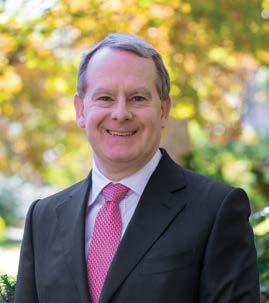
HELPING KEEP THE ENTREPRENEURIAL spirit alive, CLOCKWISE FROM ABOVE: Alex Robinson ’96, hopes his gift will allow future Fords to reap the benefits of experiences like the summer internship on Capitol Hill that changed his career trajectory; Jim Kinsella ’82 and his business and life partner Bob McNeil donated with the goal of fostering entrepreneurialism to effect positive change; and pioneering orthopedic surgeon Bill Harris ’47, shown with Haverford President Wendy Raymond, calls himself an “accidental entrepreneur” and wants to make it easier for others to follow in his footsteps.
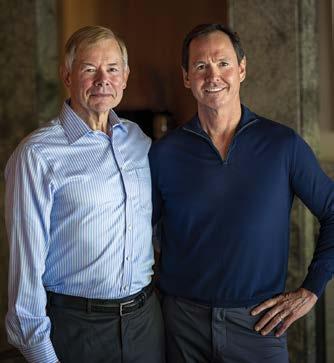
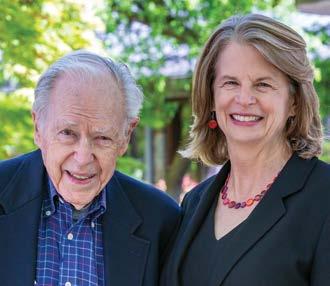
ALUMNI GIFTS HAVE LAID THE GROUNDWORK FOR THE HAVERFORD 2030 STRATEGIC PLAN, WHICH PROMISES TO DELIVER BETTER LEARNING WITH A BROADER IMPACT.
ABy Lini S. Kadaba
S A RISING SOPHOMORE AT HAVERFORD COLLEGE, Alex Robinson ’96 spent the summer interning on Capitol Hill. The position was unpaid, and to cover his rent and other expenses, the economics and math major worked at a movie theater several nights a week— all while interning full-time.
“It was hard, but absolutely worth it,” says the co-founding partner of New York City-based Tenor Capital Management Company, where he also heads research. “That summer experience was as much a part of my growing up as going to classes and developing friendships and participating in clubs.”
It also proved an invaluable turning point that made him realize his fascination with politics might not prove as fulfilling a career as he had expected, leading him to finance. The experience drove home the importance of career-oriented summer jobs to not only build professional skills, but also to learn something about oneself.
To that end, Robinson and his wife, Monica, are giving $2 million to the College to support summer experiences for all, ensuring that every Ford, regardless of major, has an opportunity for at least one paid, career- or research-oriented summer internship. It is one of three major gifts recently made to the College with the goal of advancing key components of the Haverford 2030 strategic plan and vastly expanding real-world, change-making opportunities for Fords.
Michael B. Kim ’85 P’17, who has been called South Korea’s “godfather of Asian private equity,” and is the incoming chair of the College’s Board of Managers, has made a $25 million gift to launch The Michael B. Kim Institute for Ethical Inquiry and Leadership (see “Stepping Up,” p. 32). This move, Kim argues, promises to elevate Haverford as a leader in producing graduates committed to ethics-centered change for good. Meanwhile, pioneering orthopedic surgeon Bill Harris ’47, living in Lexington, Mass., and tech investors and life
partners Jim Kinsella ’82 and Bob McNeal, who live in Seattle, have joined forces to pledge $7 million toward the new entrepreneurship initiative at Haverford that would more intentionally foster entrepreneurialism— an approach the donors see as essential to delivering positive change in the world.
All together, these donations deliver on the strategic plan’s goal of “better learning, broader impact.” The internship program, clearly articulated in that plan, will allow students to test out careers in ways that can make a critical difference to their futures. Support for entrepreneurship, which suffuses Haverford 2030, is one powerful way to translate ideas into reality. And an ethics institute, also a major stated goal, undergirds the importance of a life—and life’s work—guided by a set of values.
“We know that our students and prospective students want to have an education for impact,” College President Wendy Raymond says. “They want to create solutions to vexing problems and bring those solutions to the world, and they want to do that in an ethical framework. These gifts do that.”
Harris calls himself an “accidental entrepreneur.”
In the 1970s, as a surgeon at Massachusetts General Hospital, he started to see patients with total hip replacements suffering bone loss around the implant. In total, more than a million cases of failing artificial
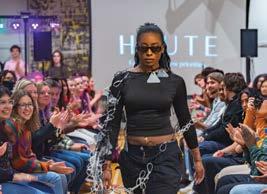
hips would emerge and eventually be traced to a biological response to submicron plastic particles from wear of the prosthesis. Harris, who was also a clinical professor of surgery at Harvard Medical School, directed the collaboration for the solution, creating a new, improved plastic material over the next decade. More than 25 years after its widespread use, the product has succeeded without causing other complications and it has helped approximately 15 million patients.
“Now, it doesn’t do a bit of good to make an invention if it’s not getting to the people who need it,” he says. Enter Harris, the entrepreneur. “I had to learn all that on the job,” he says. He chronicled the ups and downs of bringing a product to market in his 2018 book Vanishing Bone.
Harris, whose late wife was also a Bi-Co student (Johanna A. Harris BMC ‘51), hopes the gift to Haverford helps make the path for would-be Haverford entrepreneurs a bit easier.“Entrepreneurship is important to our culture, our economy,” he says, “but it’s also important to recognize an opportunity for Haverford students to have a taste in their broad liberal arts education and for Haverford to be one of the leaders in an ethical approach.”
The passionate advocate found like-minded partners in Kinsella and McNeal.
“We believe in entrepreneurialism as a force to do good in this world,” says Kinsella, chairman and cofounder with his husband, McNeal, of D4 Investments and the former president of MSNBC Digital.
Haverford has a long history of producing entrepreneurs, starting with its roots as a place to educate the children of Philadelphia’s Quaker businessmen. More recently, the College made Forbes magazine’s list of most entrepreneurial colleges.
But both as a student and later a media studies instructor at Haverford (1991–1993), Kinsella says he found a lack of formal support for people who want to make the world better through business. The new initiative promises to change that.
With a fundraising goal of $12 million, the initiative will include endowments for tenure-line faculty and support for ongoing programs. Open to all students regardless of major, the initiative will expand multidisciplinary curricular options, emphasize applied problems and solutions, and afford concrete entrepreneurial experiences, setting Fords up for even greater success as entrepreneurs from the get-go. A call for faculty proposals already elicited a dozen submissions from 10 different academic departments, and the new
program will expand and complement the Haverford Innovations Program (HIP), which earlier gifts from Kinsella and McNeal helped launch in 2017, and its Microfinance and Impact Investing Initiative (see “Risks & Rewards,” p. 50).
“OUR NOTION IS THAT WE CAN HELP DRIVE CHANGE FASTER BY PROVIDING FORDS THE TOOLS THAT WILL ALLOW THEM TO GET THEIR IDEAS AND BUSINESSES OFF THE GROUND MORE QUICKLY.”
“Our notion,” says Kinsella, who is a member of the Board of Managers, “is that we can help drive change faster by providing Fords the tools that will allow them to get their ideas and businesses off the ground more quickly.”
Kinsella, an English major, took the long route to becoming an entrepreneur. Initially, he worked in print journalism, then digital media at Time Warner and MSNBC. At each place, he says he proposed ideas (like searchable databases) that held the potential to change the game. Buy-in, though, was frustratingly slow to come. That led him and McNeal, a former Air Force pilot, to strike out on their own, buying and selling tech companies.
The experience, Kinsella says, only reinforced the need for more entrepreneurial instruction at the school. “If we’re really going to continue the Haverford purpose—making change for social good— it has got to, in 2024, include businesses,” Kinsella says. “And not just working at a business, but building businesses.”
The College’s embrace of entrepreneurship and internships—and the prominent role both play in the strategic plan—might worry some and seem out of sync for an institution that prides itself on its liberal arts focus. But this isn’t about establishing a business school at Haverford, all three donors and the College make clear.
“Specialists aren’t going to orchestrate the way to a broader solution,” says McNeal.
“It’s far more important to know how to frame an idea,” adds Kinsella, “and ideas come from all sorts of places.”
A document that outlines the program talks about an entrepreneurial spirit, embedded in Haverford’s culture since its founding, one “anchored in a high degree of student autonomy inside and outside of the classroom” and evidenced in the student-governed Honor Code and required capstone project. “Just as entrepreneurship is closely associated with economic market disruption and the creation of new forms of economic value,” it says, “a liberal arts education focuses on
—JIM KINSELLA ’82, BOARD OF MANAGERS
disruption and creation as core subjects of study.”
“It’s creative problem solving,” says Raymond. “This is about translating this rich and robust liberal arts education into not just theoretical or possible solutions, but practical impact sooner.”
Already, HIP Associate Program Director Shayna Nickel lays the groundwork for student ventures through workshops, hack-a-thons, and “pitch events,” as well as an eight-week summer Innovation Incubator. The gifts, she says, will offer even more opportunities. “Our students are really engaged with the learning and possibilities coming out of discussion in the classroom and with peers,” she says. “They really want to activate some of these ideas.”
The incubator, in particular, provides support through grants for selected teams of students to test ideas and build prototypes while interacting with industry leaders, Nickel says. “They can start to see some of these ideas coming to life or some assumptions fall short,” she says. “It’s an opportunity to build on skills students want to learn to be change makers or entrepreneurs.”
As inaugural incubator fellows, Rebecca Fisher ’18 and Joey Leroux ’18 fleshed out Beyond the Bell Tours, a Philadelphia tour company they founded to highlight stories of women, people of color, Indigenous communities, queer folks, and others often left out of the white Founding Father history of Philadelphia. They wrote and led tours, attended a tourism conference, and learned the basics of starting a business, says Fisher, who majored in Italian with a concentration in peace, justice, and human rights.
“The incubator was the turning point,” says Fisher, who applauds Haverford’s expanded investment in internships, innovation, and entrepreneurship. “We never would have taken the risk without that. We needed the mentorship and guidance.”
Frequent contributor Lini S. Kadaba is a former Philadelphia Inquirer staff writer based in Newtown Square, Pa.
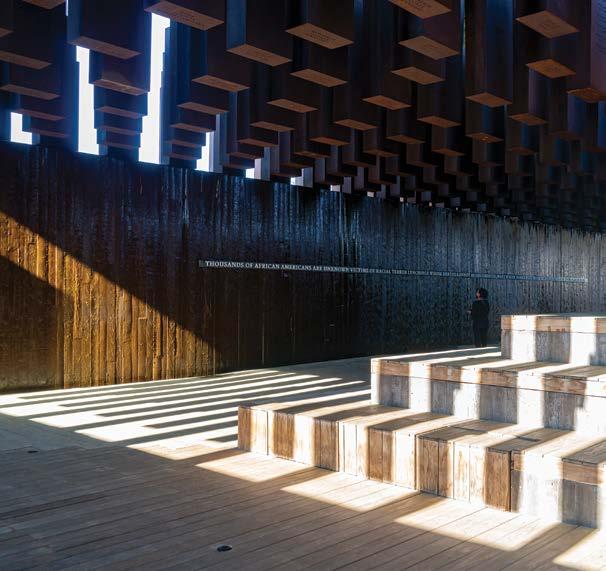
On a spring break trip organized by Haverford’s Institutional Diversity, Equity, and Access division, students, staff, and faculty got an in-depth look at the Civil Rights Trail, and a glimpse into the country’s fractured history. BY
PATRICK MONTERO
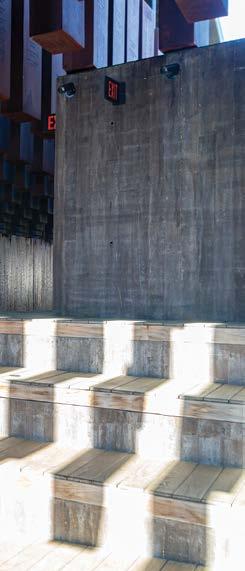
a small group of Haverford students, faculty, and staff embarked on an immersive journey along the Civil Rights Trail. The trip, envisioned by Haverford’s Institutional Diversity, Equity, and Access (IDEA) division as an annual spring break undertaking, illuminated the history of America’s marginalized people and fostered a deeper understanding of the nation’s complex past.
The group members immersed themselves in significant civil rights sites across Georgia, Alabama, and Tennessee. From Martin Luther King Jr.’s birth home in Atlanta to the emotionally charged National Memorial for Peace and Justice in Montgomery, Ala., each leg of their journey offered a poignant reminder of the struggles and resilience that continue to shape American society.
Assistant Vice President for Institutional Equity and Access Sayeeda Rashid, who led the trip, curated an itinerary that carefully balanced educational rigor with moments of bonding and respite. The trip’s highlights included visits to landmarks like the Edmund Pettus Bridge and the National Civil Rights Museum, where the impacts of past marches and protests continue to reverberate.
These photographs, just seven of the hundreds captured, provide a visual narrative of the places the group visited and the stories they uncovered.
To see a full online gallery of the trip, visit https://hav.to/kpg
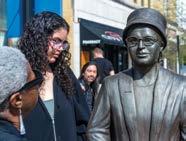
Angel Howzell and Deyana Abdelhady ’27, ABOVE, get a closer look at a bronze statue of civil rights pioneer Rosa Parks, installed in downtown Montgomery just feet away from where she famously protested segregation laws and refused to give her bus seat to a white passenger.
Inside the National Memorial for Peace and Justice in Montgomery, OPPOSITE , 800 weathered steel columns hang from the roof, each etched with an American county and the names of those who were lynched there. “We went really early in the morning when it was quiet and peaceful. That was my moment,” Rashid says of the trip.
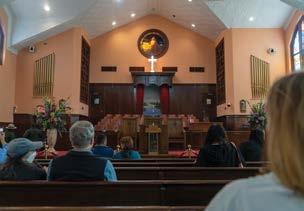
The group crossed the Edmund Pettus Bridge, BELOW, retracing the steps of 600 activists, including the late Congressman John Lewis, who faced brutal attacks from law enforcement in a 1965 march dubbed “Bloody Sunday.” IDEA Fellow Sachio Takashima phoned a friend and co-workers at Haverford as the group crossed, so they could participate virtually. “As we silently marched along the bridge, there was very much a sense of having our Haverford community with us,” he says.
Atlanta’s historic Ebenezer Baptist Church, LEFT, is best known as the home congregation of Martin Luther King Jr., who was a pastor there until his death.
Associate Director of Donor Relations Kim Graham and trip leader Sayeeda Rashid cut loose in the Soul Train exhibit at Memphis’ Stax Museum, BELOW. The museum is located on the former site of Stax Records, a label that launched the careers of musicians including Otis Redding, Isaac Hayes, and Booker T. & the M.G.’s.
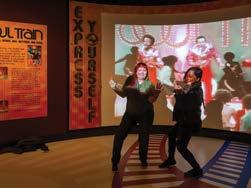


Students Paeton Smith-Hiebert ’26, and Astrid Bemis-Driscoll ’26 explore an exhibit at the National Voting Rights Museum and Institute, LEFT. It highlights artifacts relevant to the voting rights struggle in America.
A wreath outside room 306 at Memphis’ Lorraine Motel, BELOW, marks the location where Martin Luther King Jr. was shot the morning after delivering his final speech, “I’ve Been to the Mountaintop,” in 1968. Early in its history, the motel was only accessible to white people, but after World War II it became one of Memphis’ few Black-owned establishments. In 1991, the motel was converted into the National Civil Rights Museum.
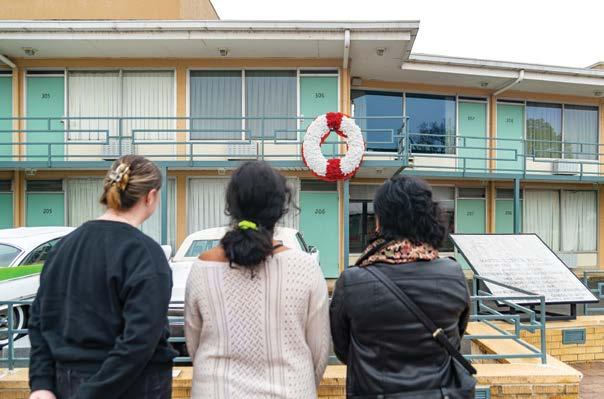
After a successful career in the nonprofit world, Joy Zarembka ’94 chose a thriving D.C.-area restaurant group where arts, culture, and opportunity are on the menu as her second act. Her goal, then and now: make the world a better place.
BY EILS LOTOZO PHOTOGRAPHY BY HOLDEN BLANCO ’17
Running a social justice think tank and running a chain of restaurants might seem like they have little in common, but Joy Zarembka ’94 knows differently. She’s done both.
For more than 14 years, Zarembka, who earned a master’s degree in international relations from Yale, played various leadership roles at the Institute for Policy Studies in Washington, D.C. She focused on the issue of human trafficking, became an expert witness on the subject, and even contributed a chapter to Barbara Ehrenreich and Arlie Hochschild’s book, Global Woman: Nannies, Maids and Sex Workers in the New Economy
Today, as the chief operating officer of the Busboys and Poets restaurant group, overseeing more than 700 employees and eight bustling locations in D.C.,


Joy Zarembka '94, shown at the newest location of Busboys and Poets in Columbia, Md., was drawn to what she sees as “a value-driven company committed to community development and providing a space for social change.”
Maryland, and Virginia, Zarembka has become a very different kind of expert. “My job is solving problems,” she says. And not just bottom-line problems. She may have left the nonprofit world, but thanks to the unusual profile of Busboys and Poets, Zarembka’s work still centers on trying to make the world a better place.
Founded by Iraqi-American artist, progressive activist, and restaurateur Andy Shallal, the Busboys and Poets restaurants are “a space for art, culture, and politics to intentionally collide,” according to its website. Zarembka calls the operation “a value-driven company committed to community development and providing a space for social change.”
Each of the restaurant’s eight locations, which serve breakfast, lunch, and dinner, feature in-house bookstores and separate event rooms that regularly host Busboys and Poetssponsored happenings, including open mic poetry nights, a discussion series on race, a “Cinema for a Conscious Community” film series, and a “Peace Café” aimed at bringing Arabs and Jews together.
Later, Zarembka will take a Zoom meeting about new payroll software in the restaurant’s empty event space, the Guillén Room, named for Cuban poet Nicolàs Guillén. On her way out, she checks out the bookstore, which commands a large area in the center of the restaurant, and chats with the young manager, who relates that nature-themed books have become a popular sales category recently. (Bookmarks given with each book sale bear the company slogan: “Feed your mind, body, and soul.”)
“I SPEND A LOT OF TIME LOOKING FOR THE LIGHT IN PEOPLE. IT MAKES LIFE EASY WHEN YOU SEE PEOPLE’S LIGHT SHINE.”
The rooms are all named for an activist, poet, or performer—each with a personal connection to the neighborhood— and are decorated with striking murals (painted by Shallal) featuring their namesakes. Among them: Paul Robeson, Pearl Bailey, Angela Davis, Howard Zinn, and Lucille Clifton. The Langston Room at the group’s flagship 14th & V location honors poet Langston Hughes, who once worked as a busboy in D.C. and inspired the name Busboys and Poets.
“Being committed to the community is really important for us,” says Zarembka, who notes that the group’s restaurant in D.C.’s Anacostia neighborhood was a result of popular demand. “Anacostia had not had a full-service, sit-down restaurant for many years, and the community spent four years trying to lure us,” she says. “Some residents even created a campaign with posters to get us to consider it.”
REFORM On a cloudy April day that threatens rain, Zarembka is piloting her dark blue Acura SUV around D.C. and its environs, calmly navigating the metro area’s heavy traffic as she pops in for visits to different restaurant locations. She has a visiting Haverford magazine writer in tow, but otherwise this is a typical peripatetic workday for Zarembka.
This morning, at the Takoma location—in a D.C. neighborhood bordering Takoma Park, Md.—she has checked in with staff, had a bite to eat, and noted approvingly the bold, pop art-influenced digital prints decorating the dining room, part of artist Hadiya Williams’ “Griot Collection” series of portraits of Black women. (All of the restaurants feature changing art exhibitions by D.C.-area artists, organized by the restaurant group’s own curator.)
“We would never survive if we were just a bookstore, but it really works in combination with the restaurant,” observes Zarembka. “I handle all guest complaints for our eight restaurants and I rarely get complaints that it took too long to get seated. The bookstores are a wonderful distraction.”
Zarembka found her way to Busboys and Poets through a personal connection with founder Shallal, who launched the restaurant concept in 2005. Zarembka got to know him when he served on the board of the Institute for Policy Studies, and he had the chance to observe her in action when she managed a 50th anniversary celebration for the nonprofit, staging 23 events in three days.
Zarembka volunteered as a campaign manager when Shallal embarked on a quixotic run for mayor of D.C. in 2014. (He lost.) Soon after, he told her about an opening at Busboys and Poets running the events department. Zarembka jumped at it. “I’d already had every position that was available [at the Institute]. At the time, I was interim executive director, and I realized I really didn’t want to spend the rest of my life fundraising.” Plus, during the mayoral campaign, she’d paid regular visits to the townhouse that serves as the group’s corporate headquarters and thought, “This seems like a really fun place to work.”
So in 2014, Zarembka became VP of planning and innovation. (In the Busboys and Poets universe, “VP” stands for “vision preserver.”) “It was a vague title that allowed me to do anything and everything,” she says. As it happens, she’s still involved in fundraising, only now it’s through a “roundup” option on guest checks that brings in $40,000 annually, donated to area charities.
Part of the vision for the restaurants as places of opportunity and community support, she says, includes a wide open door when it comes to hiring. Before it became a law, for example, the restaurant group spearheaded a “ban the box” policy, which removes questions about previous criminal convictions from employment applications. Says Zarembka,
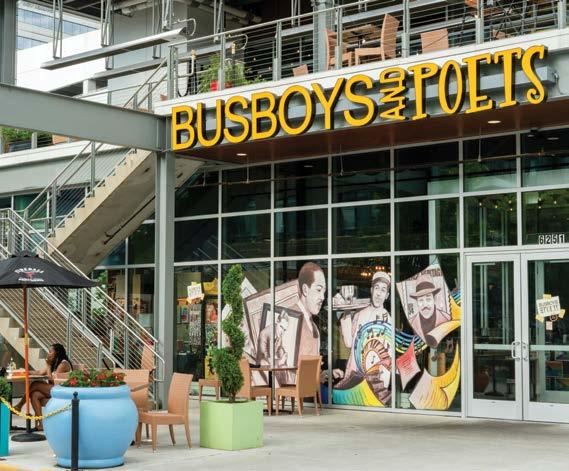
A mural by local artist Mia DuVall, ABOVE, nods to the inspiration for the name of the restaurant group with its depiction of Langston Hughes as both a busboy and a poet.

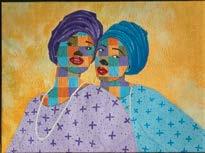
The interior serves as a gallery for paintings like Faces of Africa II by Nigerian artist Franklin Eze, LEFT, on loan from Anacostia Art Gallery and Boutique in Washington, D.C. In some cases, the art on display has QR codes guests can use to contact the artist for purchase. Busboys and Poets takes no commission on the sold artwork.
“I don’t care where you went to school. I don’t care what you did before you walked in that door. What I want to know is, ‘Do you want this job?’”
For Zarembka, who was born into a Quaker family, one tenet of her faith really speaks to her. “Quakers say, ‘There is that of God in everyone.’ I spend a lot of time looking for the light in people. It makes life easy when you see people’s light shine. We are a place of second chances. I assume that they are going to do their best and that we are going to help them strive forward.”
Busboys and Poets tries to do the right thing by its employees in other ways, too. Those who work full-time hours— something the company tries to make easy to achieve, says Zarembka—have access to a variety of benefits, including

health insurance and a 401K plan with a 5 percent match from the company. That is a rarity in the restaurant business.
“The restaurant industry is an institution that is known for sexual harassment, wage theft, and not following safety precautions,” she says. “We’re trying to do things differently.”
TO PURPOSE Zarembka lives with her 14-year-old daughter, Jayla, and a cavapoo pup named Nala in a townhouse not far from the Takoma Busboys and Poets outpost. Her partner of 15 years, Cynthia Martin, who works in pharmaceutical sales and also has a teen daughter, Skylar, lives in Bowie, Md. “We both enjoy our own space, so we don’t live together,” Zarembka says.
Zarembka, whose last name is Polish, grew up in Pittsburgh. Her father, a white man from St. Louis, had met her mother, a Black woman, in Kenya while in the Peace Corps after college.
“My brother Tommy and I lived in this little slice of heaven next to a working class Black neighborhood and a middle class Jewish neighborhood,” Zarembka says. “So I grew up there in this multi-culti family in the 1970s and ’80s and I thought it was the norm. I did not realize how lucky we were.”
Her parents divorced when she was 15, with her mother staying in Pittsburgh and her father moving to the Washington, D.C. area. After undergrad at Haverford and grad school at Yale, Zarembka settled in the same area. (Her brother Tommy and adopted brother Douglas live there as well.) Her mother eventually bought a house across the street from Zarembka and helped raise her daughter for a time, before moving back to run a farm in Kenya. Her father married another Kenyan woman and moved back to Kenya in 2007 to lead an organization focused on conflict resolution. Sadly, he and his wife died of COVID-19 within a week of each other in 2021.
Zarembka grappled with the complexities of race at Haverford, which was not as diverse as she had hoped. “I felt like it became my full-time job to be a spokesperson for the entire African American race,” she says. “It felt a bit exhausting to be educating educated people.”
Still, she loved the athletic opportunities Haverford provided. She was captain of the soccer team, a walk-on to the basketball team, and was named All-American her sophomore year for lacrosse, a sport she had never seen or played before Haverford.
During that year, her roommates were two senior sports standouts, Amy Taylor Brooks ’92 (volleyball, basketball, lacrosse) and Becca Fernandez ’92 (field hockey, lacrosse). “They loved to cook, and I loved to clean,” Zarembka says. “It was a magical year for me.”
A sociology major at Bryn Mawr, she also has fond memories of the program that allowed her to spend a forma-
At each of the eight locations, owner
tive semester as an exchange student at historically Black Spelman College in Atlanta, and in the classroom of sociologist Bill Hohenstein, now a Haverford professor emeritus. “He made us go out into the real world,” she says, recalling one particularly memorable excursion to the race track to observe gamblers.
An independent study she did her senior year on racial identity and transracial adoption inspired her application for the Watson Fellowship, which she won, thanks to the help of former dean Steve Watter, who she calls “the greatest guy in the world.”
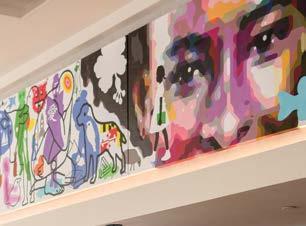
“THE QUESTION IS: HOW DO YOU DO WELL WHILE DOING GOOD?”
“Being given money to travel the world at that age was incredible,” says Zarembka, who used the Watson funds to journey post-graduation to England, Kenya, Zimbabwe, and Jamaica to research multiracial identity.
“I wanted to get interesting people to talk to me, so I thought, ‘I’ll just say I’m writing a book.’ Then, once I started saying that, I felt duty bound to actually write a book. It took me forever, but that gave me the excuse to return to those countries to re-interview people.” Finally, in 2007, she published The Pigment of Your Imagination: Mixed Race in a Global Society. She held her book launch in the Langston Room at Busboys and Poets’ 14th & V location, not knowing at the time that her path would ultimately lead her back there in a much larger way.
Busboys and Poets’ efforts to do good—beyond just cooking up a great blackened salmon or shrimp and grits—have ranged from serving free Thanksgiving dinners at different restaurant locations each year, to shutting down the restaurants to mark “A Day Without Immigrants” in 2017. Other, more provocative, moves have not won fans. A “Race Card” initiative, for example, in which the restaurants’ servers passed out cards bearing hard questions about race to customers, received criticism on social media.
Balancing a commitment to social justice with the need of a business to make money isn’t easy, Zarembka acknowledges. “Restaurant profit margins are so low. The question is: How do you do well while doing good?”
Busboys and Poets seems to have found a way with its earnest yet business-savvy concept, which provides multiple
revenue streams (full-service bars, food sales, bookstore sales, and event space rentals), and multiple ways to attract customers. Says Zarembka, “People might come for an event and discover the restaurant, or they’ll come for a meal and end up buying a book.”
Annual revenues for the group are approximately $50 million, according to Zarembka, who moved up to the chief operating officer role in 2022, after helping to successfully navigate the pandemic. “I credit online ordering with our survival,” she says. She did some hardball negotiating with online delivery services such as DoorDash and Grubhub to reduce their high fees and engineered a way for customer orders to go straight to the kitchen. “By leveraging technology, we could do delivery and to-go orders much faster and cheaper than other places,” she says.
Part of Zarembka’s portfolio as COO is strategizing on how to scale up the business—which has had numerous overtures from other cities, including Denver, Oakland, and Philadelphia. “It’s usually a developer who would like to see us as an anchor in a project they are building,” she says. (A Baltimore location was shut down in 2022 after only two years, hampered by the building’s too-small footprint.)
Currently, the company is contemplating two new locations: one at an area airport and another at the historically Black college Bowie State University in Maryland.
For the founder of Busboys and Poets, opening more restaurants is not really about boosting profits, says Zarembka.
“It sounds crazy, but Andy isn’t really about the money, and expansion doesn’t necessarily make us more money. It’s really about the expansion of influence, jobs, and opportunity,” she says. And, for Zarembka, it’s also something personal. “I want my daughters to walk into our restaurants and see reflections of people who look like them—in the books, in the art, in the food, in the music, in the events, in the staff.”
Eils Lotozo is a freelance writer who focuses on food, farms, gardens, sustainability, and home.

BY BEN SEAL
As the 10th anniversary of Haverford’s Microfinance and Impact Investing Initiative passes, students continue to reap the benefits of a program that provides real-world experience.
race Mathis ’19 didn’t know what she was looking for until she found it.
She was approaching her senior year at Haverford, majoring in political science with a minor in environmental studies, and struggling with the pessimistic tone of conversations about climate change. She knew it was a dire issue, but she wanted to find a way to make a difference, rather than lamenting the status quo. An environmental studies professor recommended she look into a class that might at first blush seem to have little to do with her goals: ECON298. When she walked into Shannon Mudd’s classroom that fall, though, everything fell into place.
Mudd, an assistant professor of economics and director of Haverford’s Microfinance and Impact Investing Initiative (MI3), describes impact investing as “investing not only to generate an expected financial return, but also a positive social or environmental benefit.” Its practitioners are as concerned about doing good as they are about doing well. For Mathis, this meant a way to address the ongoing climate crisis by finding and backing the environmental solutions that offer a way forward.
“It gave me a sense of purpose and hopefulness I didn’t always have when
discussing these issues, and made me feel empowered to actually do something about it,” Mathis says. After years fumbling around in the dark for a more optimistic way to approach the environmental crisis, “it was like a light switch,” she says.
Over the course of that fall semester, Mathis and 15 classmates studied the theory of impact investing and the tools of the trade, then put it all into practice in an unusually hands-on demonstration of everything they had learned. They performed due diligence on real companies and decided as a group which one they should invest in—with real money provided by a sponsor.
Five years later, Mathis is part of the climate team at investment firm Hitachi Ventures and a member of the impact investing class’s alumni advisory board, which helps vet the current class’s investment opportunities.
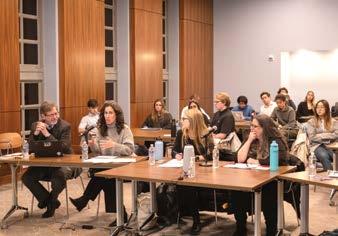
Many students enter Mudd’s classroom unaware that some investors are concerned with more than just financial returns. For 10 years now, he’s been helping them realize that the field of investing includes opportunities to make the world a better place.
In ECON298, he teaches students methods to gauge anticipated return on investment and how the SWOT analysis (an acronym that stands for strengths, weaknesses, opportunities, and threats) can help investors scope out a company’s place in the market. His students also learn how to measure a company’s expected impact, which is often more challenging than financial forecasting.
But it’s the practice component that opens students up to impact investing’s potential. The final third of the semester is devoted to performing due diligence on four investment opportunities and putting as much as $25,000 from the course’s sponsor, Overseas Resources Foundation Limited (ORFL), into the best one. That money will be monitored by Haverford students long after the class ends and, if all goes well, reinvested in more early-stage enterprises to compound its impact.
“The market is a human invention. It’s been evolving and will continue to evolve, but we can be a part of bringing some intention into how it’s going to evolve going forward,” Mudd says. “Part of that can be the expectations shareholders have for the companies in which they invest.”
More than a decade ago, Mudd was a visiting assistant professor in business and economics when he heard that a Haverford alumnus wanted to support students learning about microfinance, an economic practice that gained popularity in the 1980s before criticisms of its efficacy arose in the early 2000s. The premise was that small loans of a few hundred dollars or less could help entrepreneurs in developing countries, where a little investment goes a long way. The practice was intended to lift people out of poverty and pave the path to self-sufficiency by backing marginalized groups that are often excluded from traditional financial assistance.
After suggesting a series of experts the College could bring in for the project, Mudd decided to put in a proposal of his own. To his surprise, it was accepted, with one small change: the addition of a few words that urged the program to get students involved in “socially responsible investing,” he says.
Mudd offered a non-credit six-week seminar on impact investing to gauge student interest. When 30 students showed up, he knew he’d struck a chord. From that seed grew a series of courses: one on the theory, practice, and challenges of microfinance; a research seminar focused on
access to finance; and the hands-on impact investing class.
Actual investing wasn’t originally part of the curriculum, but when Mudd learned that ORFL, the socially driven Hong Kong-based foundation that supports his position and programming, would provide seed money for his students to invest, he knew it would be a one-ofa-kind learning experience for students.
“I discovered an opportunity to collaborate with a local group of impact investors from Investors Circle, but it was pretty scary for me,” he says. “The kind of early-stage angel investing they were doing was much higher risk than I ever would’ve considered. But to bring students into these meetings, for them to be in the room where it happens, to hear the pitches, the kinds of questions investors were asking, what they think is most important—the educational opportunity was just phenomenal.”
Students who have taken the class agree. Seth Maerowitz ’79, who worked on Wall Street and started his own software business, returned as a member of MI3’s Investment Advisory Council, which is composed entirely of Haverford alumni. “I went to business school and I don’t think I had a class at MIT that was as relevant to my work as that class is for students interested in impact investing,” he says.
In the latter part of the semester, Mudd presents the class with a long list of investment opportunities, generally companies with a broad range of social and environmental goals and an even broader range of ideas for how to achieve them. Students apply new tools, processes, and methodologies for evaluating these potential investments
“The optimism with which we approached the class set the stage for me to understand that the best way for me to make an impact was to find the exciting solutions for this really difficult—frankly, frightening—issue.”
to whittle the list down to four finalists, then split into four-person teams to perform due diligence on each. They analyze the competition, estimate impact, and assess each company’s future prospects, often speaking with founders, industry experts, and other investors along the way to have all their most pressing questions answered.
The class culminates in presentations to the advisory council members, who poke and prod the possibilities with an investor’s eye, followed by a long discussion over dinner to determine which company represents the best opportunity. It’s like a scene from Shark Tank, if doing good was the primary motivation. The class is open to students in any major, so long as they have taken introductory economics, ensuring the room is full of a variety of perspectives.
When psychology major Allison Cubell ’24 took the impact investing course in her junior year, the class invested in Both&, which makes clothing for the queer and nonbinary communities. She plans to work in the fashion industry after graduation and calls the class “the most realworld thing I’ve experienced in college.” She appreciates the chance to develop financial literacy while playing an actual role in the investment process—not just reading about it. The class’s lessons are amplified by the weight of guiding real money toward real businesses that want to make a meaningful difference in the world, she says.
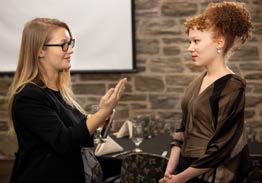
The education doesn’t stop when the semester ends. Cubell is one of many past students who returned as volunteers tasked with monitoring the class’s portfolio and preparing reports for ORFL.
“The skills I’ve gained following up and monitoring these companies, I don’t know where else I’d ever be able to get those skills in college,” Cubell says.
For economics major Kyle Huey ’25, who took the class last fall, it was something of a revelation. He wasn’t familiar with impact investing and had never heard of
“The skills I’ve gained following up and monitoring these companies, I don’t know where else I’d ever be able to get those skills in college.”
—ALLISON CUBELL ’24
microfinance, either. The whole concept of using money to promote social good felt a little foreign to him, but by the end of the semester, he had experienced something he’d never encountered in another class. “It was almost as if we were doing the work of a real investor,” he says, which was precisely Mudd’s intention when he designed the class.
Like Cubell, Huey is working with Mudd to monitor the portfolio to continue what he calls the “fulfilling work” of impact investing. He plans to work in finance after he graduates, but now he’s thinking about how he can use what he’s learned to promote social good.
CONSENSUS Agreeing on what final business to invest in is often the most difficult part of the class. Mudd requires students to reach a consensus, in keeping with the Quaker way. It can be challenging to remain impartial and accept that the business they’ve spent weeks studying may not be the best option.
“I went to business school and did a similar exercise, and I saw a lot of students, becoming defensive about
the companies they were pitching and having a hard time being objective,” Mathis says. “It’s quite difficult.”
Last fall, when two businesses looked like clear candidates, the class ended up splitting their investment between both: FRSH, which offers financial technologies to the formerly incarcerated, and Afterlife, which turns food waste from New York City restaurants into substrate for mushrooms that are then sold back to restaurants. (Mudd asked one of the businesses to lower its minimum investment to make both investments feasible.)
Mathis says that the presentations and debate over the final project closely mimic the experience of being on a real investor committee. She also credits Mudd’s class as “instrumental” in her path toward professional impact investing with a climate focus.
“The optimism with which we approached the class set the stage for me to understand that the best way for me to make an impact was to find the exciting solutions for this really difficult—frankly, frightening—issue,” Mathis says.
Impact investing is a long game. It typically takes about eight years to get a return, Mudd says. The dozen or so firms his students have invested in help illustrate the uncertainty. One returned double the investment in two years (CodeMonkey, which uses gamification to teach kids coding), while two others closed up shop.
In the decade he has taught the class, Mudd says his proudest moment came four years ago when his students scoured their options and ultimately determined they weren’t confident enough to invest in any of them.
“To have money on the table and walk away from making an investment shows you how seriously the students take this,” Mudd says.
In the quest to turn financial might into social good, there are no easy answers, but his students are committed to finding the right ones.
Ben Seal is a freelance writer whose coverage includes psychedelics, environmental policy, and academic research.
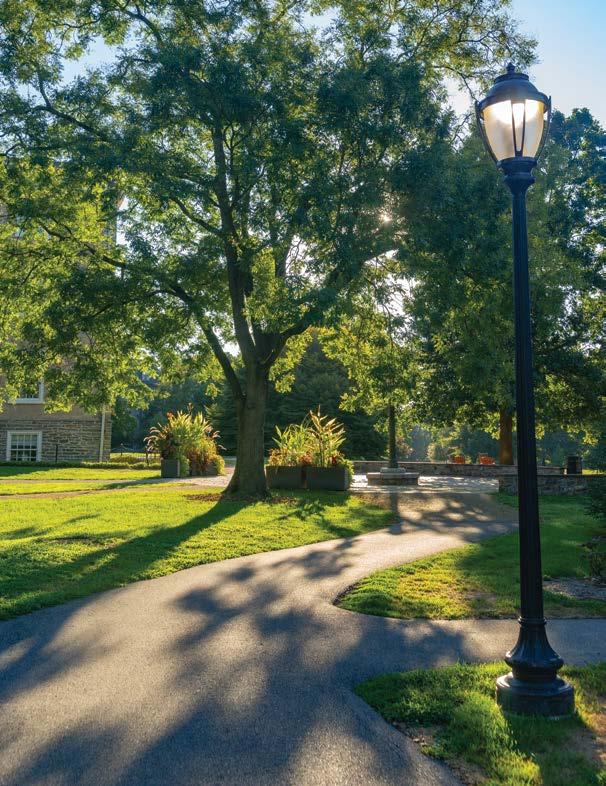
These eight Haverfordians were recognized during Alumni Weekend for their service to the College, society, and their professions.

The KANNERSTEIN AWARD for loyal and active service to the College was presented to Ann West Figueredo ’84, P’12, P’22. Ann served in the Institutional Advancement office at Haverford from 2008 to 2020. As vice president of Institutional Advancement, she planned, executed, and stewarded the largest comprehensive capital campaign in Haverford’s history, raising more than $270 million. She was also instrumental in the launch of numerous alumni affinity programs to keep Fords connected to each other and to the College. She is currently a principal and co-founder of Momentum Consulting Group.

The HAVERFORD AWARD honored Alexia Kelley ’89 for her work at the intersection of faith, social justice, and impact. She served as the deputy director of the White House Office of Faith-based and Neighborhood Partnerships, and worked for 10 years in the U.S. Conference of Catholic Bishops’ Catholic Campaign for Human Development. Alexia currently serves as the president and CEO of FADICA –The Catholic Philanthropy Network, where she has led partnerships globally and in collaboration with the Vatican to respond to the Ebola crisis in West Africa, the COVID pandemic, and human trafficking.

The DISTINGUISHED ACHIEVEMENT AWARD recognizes outstanding accomplishments in an alumni’s field, and this year was awarded to John Melle ’77. He enjoyed a 32-year career at the Office of the United States Trade Representative, where he negotiated and oversaw imple-
mentation of agreements with Chile, Peru, Central America, the Dominican Republic, Panama, and Colombia. The bulk of John’s career also included implementing and renegotiating major trade agreements, including the North American Free Trade Agreement and the 2020 United States-MexicoCanada Agreement.

The FORMAN AWARD, which honors Larry Forman ’60 and recognizes alumni athletes devoted to the betterment of society, went to Matt Leighninger ’92, P’20, P’24. Matt directs the Center for Democracy Innovation at the National Civic League, one of America’s oldest good governance-organizations. He leads the Center’s work in strengthening civic infrastructure, using technology to scale engagement, and measuring the quality of participation and democracy. Matt dedicated his first book to Haverford cross country and track coach Tom Donnelly, who he credits as both a premier educator and a “builder of democratic institutions.”

The WILLIAM KAYE AWARD recognizes exemplary volunteer service in the area of career development and honored Matthew Jennings ’99. Matthew has more than 25 years of broad commercial and strategy experience focused on identifying, understanding, and developing solutions to address problems within organizations as well as for customers and manufacturers. He has experience working for a variety of companies, from startups to large public and private firms, and is currently in his 19th year at DLL, a leading international equipment finance company.

The MACINTOSH AWARD for outstanding service as a College Admission volunteer honored Charles Robinson ’89. He credits the Quaker values of consensus building with much of his success in his varied international experiences in business and investing. Most recently, he is serving as managing director for Heitman, a major real estate firm with offices in Europe, the Middle East, and Africa. He is a tri-national citizen of the United States, France, and the United Kingdom. Charles has served on Haverford’s Advisory Committee and continues to help promote the college internationally.
The YOUNG ALUMNI AWARD recognizes established and future leaders among Haverford alumni who have graduated in the last 10 years. This year, it went to two recipients.

Rebecca Chang ’19, an organizer at the United Food and Commercial Workers (UFCW) Local 663, the largest private-sector union in Minnesota that represents grocery, retail, meat-packing, and food processing workers. The UFCW Local 663 empowers workers to unionize and fight for better wages and benefits, as well as safer working conditions.
At Haverford, Rebecca was also one of the student leaders who brought the Pan-Asian Resource Center (PARC) into being. Currently, it continues to be an active and central space for Asian and Asian American students.

Talia Scott ’19 was inspired to increase the number of Black women lawyers and motivated by the prohibitively high costs associated with law school applications. She created the Legally BLK Fund, which initially had the modest goal of raising $5,000 to support the costs of applying to law school for five Black women. Today, the Legally BLK Fund has raised more than $14,400, which will support 10 Black women on their journeys to law school. Currently, Talia works as a banking and credit paralegal at Cravath, Swaine & Moore, where she has also taken on pro bono immigration work.
At its April meeting, the Haverford College Board of Managers welcomed the following new members:

Seth Bernstein ’84 currently serves as president and chief executive officer of AllianceBernstein Corporation and is senior executive vice president and head of investment management and research of Equitable Inc. Seth is also a director of AllianceBernstein Corporation. He is a former member of the Board of Managers (2010–2022). Seth and his wife Toni have three children: Hilary, Samuel, and Max. The family resides in New York City and New Hope, Pa.

Tracey Hucks is a nationally known and esteemed scholar of Africana Religious Studies. She is the Victor S. Thomas Professor of Africana Religious Studies at Harvard Divinity School and the Suzanne Young Murray Professor at the Radcliffe Institute for Advanced Study. Prior to that role she served as Provost and Dean of the Faculty at Colgate University. Hucks previously taught at Davidson College and for eighteen years at Haverford College, and is the incoming Recording Clerk of the Corporation of Haverford College.

Douglas Koshland ’76, P’08, P’11 is the Richard and Rhoda Goldman Distinguished Chair in the Biological Sciences and professor of genetics, genomics, and development at the University of California, Berkeley. During the Lives That Speak campaign, he established the John P. Chesick Scholars Program and Office of Academic Resources Fund. He is board chair at the Science Communication Lab and is also president of the Life Sciences Research Foundation. Doug and his wife Mary reside in Berkeley, California.

In addition, the Board appointed Tobi Alliyu ’16 , a consultant at Deloitte and Company, to a three-year term as young alum associate manager. Prior to her role at Deloitte, Tobi was a health financing associate of the private sector at ThinkWell, a consultant at ECG Management Consultants, a program coordinator at GBCHealth, and a population health officer at Housing Works. Tobi received her B.A. in anthropology and minored in public health at Haverford. She went on to Boston University where she received a M.P.H. in global health program design monitoring and evaluation and a M.B.A in health sector management. She resides in Philadelphia.
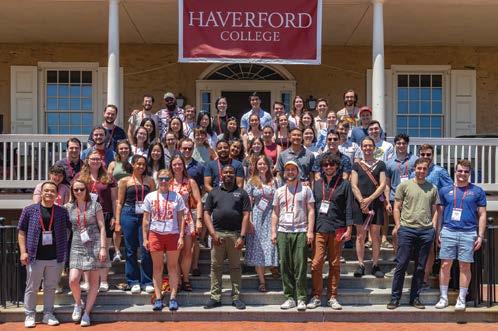
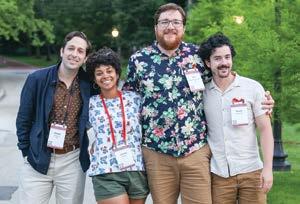

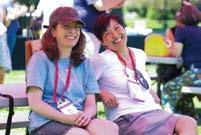
5. The Class of 1989 gathers after Saturday dinner under the tents.
6. Alumni award winner Charles Robinson ’89 accepts his award from President Wendy Raymond. More on that on page 55.
8. Moving and grooving at the Saturday dance party.
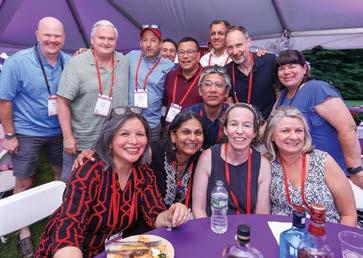
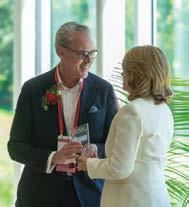
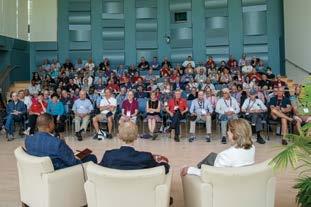


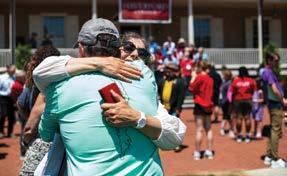
Connecting with friends at Founders
13. The black squirrel mascot high-fives a future Ford
14. Hanging out with 2019 alums after dinner on Friday night.
SAVE THE DATES FOR ALUMNI WEEKEND 2025, MAY 30-JUNE 1. All alumni are welcome and classes ending in 5 and 0 will be celebrating reunions.
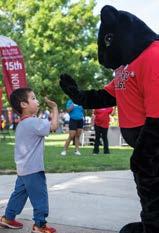

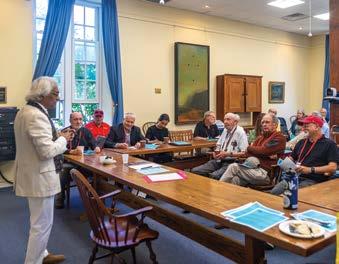
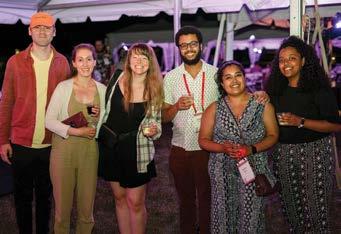
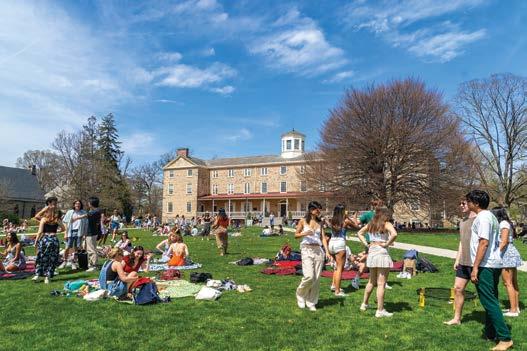
Tuesday, April 9, 2024,
this

Due to privacy concerns, the Class News section is not included in the digital edition of Haverford Magazine.

Due to privacy concerns, the Class News section is not included in the digital edition of Haverford Magazine.
The social media star found success at the unlikely intersection of art, architecture, and history.
Like a lot of people looking for a creative outlet during the pandemic lockdown, Isabella Segalovich ’19 took to TikTok. But instead of sharing dance moves and baking tips, she was talking about anti-authoritarian folk art.
She started off slowly. “I created a couple videos about what I thought was an incredibly niche interest,” she says. “I definitely fall in the category sometimes referred to as ‘EduTok,’” or educational content on TikTok.
Full of snappy prose, enticing historical tangents, and archival photos, the scripted videos she posts as @interstellar_isabellar examine the ways fascism, colonialism, and white supremacy have influenced trends in art and architecture. These subjects quickly found an audience among fans of weird history, and Segalovich’s videos started going viral.
“There’s an audience for almost anything on TikTok,” she marvels. Her video on indigenous tattoos and the bias against them in modern business culture racked up 137,000 views. Another one about the CIA’s connection to the modern art movement scored 243,000 views. More than a million people watched her video on contentious Japanese artist Yayoi Kusama.
They’re not all runaway hits, but most of Segalovich’s videos broach subjects that illuminate under-explored corners of history and activism: the Mexican and Jewish origins of bedazzled “Nudie” suits, how Picasso lifted concepts from African art, how pole climbing at sports celebrations has its roots in Italian festivals, and so on. These are all topics in Segalovich’s wheelhouse, given that she was a fine arts major with a visual studies minor.
One of her favorite subjects is ornamental design—something she’s been interested in since a family friend gave her a book called Styles of Ornament by Alexander Speltz when she was 12. “I was just mesmerized by all these intricate drawings,” she recalls. “I haven’t stopped thinking since about what drives human beings to create beautiful, detailed designs.”
Look closely and you’ll find knotty, maze-like designs in most cultures around the world, past or present, she says. It’s only in the last hundred years
or so that modernist movements, some of them with unrecognized white supremacist and fascist roots, have forced ornamental design to the fringes. Segalovich, a Philadelphia-based artist and designer, has discussed this in several of her videos, and is currently working on a book on the subject for RIBA Books of London.
Of course, while TikTok has helped her refine her voice and find her audience, the app is not without its challenges. For one thing, she’s forced to utilize so-called “algospeak”—a vocabulary of thinly veiled codewords that content creators use to sidestep algorithms that suppress touchy subjects and discussions. Like everybody on the app, Segalovich has to say “Yahtzee” instead of “Nazi,” “mustache man” instead of “Hitler,” and “unalive” instead of “kill” or “dead.”
But the aspect of the app that irks her the most is the less thoughtful, more dishonest, and salacious content she’s in de facto competition with. “And unfortunately, often, those will do a lot better on TikTok than if you do make something that’s a little bit longer, a little bit more involved with cited sources,” she says. For those reasons, she has been pivoting to other platforms, including Instagram and podcasts. Segalovich is also a producer for Hyperallergic, an independent art news organization based out of Brooklyn.
Whatever the media, she manages to find an audience, despite all the noise. “Educational-type content still works really well,” she says. “I think people are really hungry for it.” —Patrick Rapa

46
Merrill Goodman died on March 7 at age 99, following a brief illness. He spent four semesters at Haverford and two semesters through the Navy V-12 program at Swarthmore. Goodman studied medicine at the University of Pennsylvania. For nearly 50 years, he was an ear, nose, and throat physician on Long Island. In those years, he was also chair of the department at Long Island Jewish Hospital and founder and first director of the Long Island Hearing and Speech Society. Goodman was predeceased by his wife, Phoebe, and his son, Roy; he is survived by his daughter, Nancy Torpey BMC ’74, four grandchildren, and six great-grandchildren.
50 Lester R. Dragstedt, Jr., died March 30 at age 95. After completing his surgical residency at the University of Chicago, Dragstedt assisted his father in a successful operation to separate conjoined twins, the first successful separation of twins with significant connection. Over the years, Dragstedt and his father kept in touch with the twins. His residency training was interrupted by service in the U.S. Air Force between 1955 and 1957, during which he was assigned to bases in Goose Bay, Labrador, and Panama City, Florida. After completing his residency, Dragstedt and his wife, Natalie, moved to Iowa, where he served the nation’s veterans through surgical service at the U.S. Veterans Medical Center in Des Moines. He finished his last years at VA Central Iowa Health Care System, where he was chief of the department of surgery, and a clinical professor of surgery at the University of Iowa. Dragstedt is survived by his wife and six children, Lisa Rasmussen, Catherine Dragstedt, Lester Reynold Dragstedt III, Kristin Kemsley, Gail Fennelly, and Susannah Thompson; 14 grandchildren; and three great-grandchildren.
PLEASE SEND ALUMNI OBITUARIES to: alumni@haverford.edu. Or, mail to : Haverford College c/o Alumni and Constituent Engagement, 370 Lancaster Ave., Haverford, PA 19041
51 John Hume died on March 26 at age 95. He received his doctor of medicine from the University of Pennsylvania in 1955, then completed his internship at Presbyterian Hospital in Philadelphia and residency at Norristown State Hospital. From 1957 to 1965, Hume served in the United States Navy and United States Naval Reserve. During active duty at Cubi Point Naval Air Station at Subic Bay, Philippines, he was awarded a medal by the Philippine government for saving civilian lives. In his years of practicing medicine, Hume served as clinical director of Norristown State Hospital, chairman of the division of psychiatry at Polyclinic Hospital in Harrisburg, and medical officer for North Dauphin Mental Health. He was also a teaching consultant for the Commonwealth of Pennsylvania, a psychiatry instructor at University of Pennsylvania School of Medicine, and an assistant professor of psychiatry at Hahnemann University College of Medicine. In 1981, Hume decided to attend law school at Dickinson School of Law; he then served on the adjunct faculty as a professor of law and psychiatry. Hume was preceded in death by his son, John, and his brother, Alan Hume ’49. He is survived by his wife, Natalie; his children, Susan Leeson, Angelica Stetler, Daniel, Jennifer, and Summer; and two grandchildren.
54Robin Harper, a lifelong peace activist, died on Dec. 4 at age 94. He attended Deep Springs College in California, followed by a year of serving two American Friends Service Committee projects, one in a steel warehouse and another in a mental hospital. He went on to earn a B.A. from Cornell University, then an M.A. from Haverford in social and technical assistance, an experimental program that prepared recent college graduates to find meaningful work in developing countries and influenced the emergence of the Peace Corps. In 1976, he moved to Pendle Hill, a Quaker adult study center in Wallingford, Pa., where he assumed the position of maintenance manager and later became planning and construction manager. Harper led many efforts to promote peace and community throughout his life, including organizing
peace walks and vigils and participating in hundreds of nonviolent demonstrations. He helped organize the Walk for Peace to the United Nations in 1958, a demonstration for global nuclear disarmament, and set up two war tax resistance alternative funds in the greater Philadelphia area, creating revolving funds for making loans of refused taxes to worthy social change. He led delegations to visit Congresspeople, participated in radio and television interviews regarding his peace views and actions. He was predeceased by his wife, Marlies. He is survived by his three children, Heide, Eric, and Holly; and one grandchild.
56
John Buttrick, celebrated pianist and former director of music at MIT, died in November at age 88. Buttrick spent a year at Haverford before earning a B.S. and an M.S. from the Juilliard School of Music. Starting in 1961, he toured major European cities, performing in recitals and as a soloist with symphony orchestras. He also toured with orchestras and groups across the United States and Europe for most of his life. At MIT, Buttrick performed solo recitals in Kresge Auditorium and was a soloist with the MIT Symphony Orchestra on a national tour to several major American cities. Under Buttrick’s leadership, MIT’s music faculty expanded and student enrollment in music courses increased. He loved to perform Beethoven and recorded several albums of Beethoven’s music, as well as albums by Franz Schubert, Ferruccio Busoni, Joseph Haydn, Max Reger, Richard Strauss, Johannes Brahms, César Franck, and Frédéric Chopin. Buttrick is survived by his children, Miriam, David, Simon, and Michael; five grandchildren; and his ex-wife Irene.
David Greene died January 11 at age 89. He completed a PhD in electrical engineering from the University of Wisconsin, Madison. Teaching was always Greene’s passion, and he taught physics to high school, community college, and university students for more than 30 years—as well as ballroom dance, soccer, and fencing to neighborhood groups. Greene and his wife lived in Baltimore, where they raised
their children and joined the Homewood Friends Meeting. He is survived by his wife, Anne, and their four children.
57 Bill Yost died on April 24. After college he earned his JD at Yale Law School and went on to work for several national corporations during his career and was a member of the bar in Wisconsin and Texas. He retired as senior vice president, legal and secretary of Pearle Vision. A lifelong volunteer, he served as a director and officer of St. John’s Home of Milwaukee; the Milwaukee chapter of the American Red Cross; the Wisconsin, Texas, and New Mexico chapters of the Arthritis Foundation; the Bridges Project for Education in Taos, New Mexico; and the Society of the Muse of Taos. He was also a consultant for the Center for Nonprofit Management in Dallas, Texas, and was president of the Residents Council of Regents Point in Irvine. He was a member of the Sons of the American Revolution. He is survived by his wife Kate; their children, Ginny, Mumm, and Alex; and seven grandchildren.
59 Elliott Heiman died on April 7 at age 85. After college, he attended Jefferson Medical School and did his residency in psychiatry at the Institute of the Pennsylvania Hospital. During the Vietnam War, he put his medical training to use, evaluating the mental health of soldiers. He also volunteered in a Catholic orphanage working with children to determine their developmental level. After serving in the war, Heiman took a postdoctoral fellowship in community psychiatry at Yale University School of Medicine before moving to Tucson in 1970. He served as the coordinator of the psychiatric program at El Rio Neighborhood Health Center, was psychiatric consultant at La Frontera and Cochise Community Counseling Services, and medical director of Carondelet Behavioral Health Services. Heiman published 34 papers and received many awards, including the Family Empowerment Award given by AMISA (Association for the Mentally Ill of Southern Arizona). He served on the
planning board of the Surgeon General’s Report on Mental Health and was president of the Arizona Psychiatric Society. Heiman was also an accomplished artist, and had several exhibits in Tucson. He is survived by his wife, Sandra; his children, Andrea Khan ’88 and Pamela; five grandchildren; and one great-grandchild.
Don Scholl died on March 27 at age 88. Scholl studied at Temple University and the Barnes Foundation. His career went from salesman to public relations to manufacturing, until he found his calling in the 1970s: management training and consulting to the North American Certified Public Accounting industry. For 45 years, Scholl ran his own consulting firm advising CPA partners how to run their businesses better, became a thought leader in the industry, and was named one of the 100 Most Influential People in Public Accounting. Over his career, Scholl provided management consulting and training services to many public accounting firms—and he created many development programs for CPAs, including the popular Management for Results. Scholl was predeceased by his wife, Margaret. He is survived by his children, Sandra Donahue, G.R., Jonathan, and Christopher.
60Truman Bullard died March 13 at age 85. After college, Bullard pursued a master’s degree in music history from Harvard University, then a Ph.D. in musicology from The Eastman School of Music at The University of Rochester. From 1965 until 2000, he was an award-winning professor of music at Dickinson College, where he directed two choral ensembles—the Dickinson College Choir and the Chamber Choir— and taught courses in music history and theory. From 1976 to 2014, Bullard was a visiting professor of musicology at The Eastman School of Music, where he taught graduate courses in Russian music and culture. In addition, he participated in The Harrisburg Symphony Orchestra, The Buzz Jones Big Band, The Dickinson Orchestra, The Pennsylvania Council on the Arts, The Eaken Trio, The Harrisburg Choral Society, The Central Pennsylvania Symphony,
Cantate Carlisle, The Carlisle Town Band, The Messiah University Wind Ensemble, and Project Share. He was a faithful member of St. John’s Episcopal Church, where he often served as interim organist. And he was on the boards of directors of the Central Pennsylvania Youth Ballet and Market Square Concerts. Bullard is survived by his wife, Beth; his sons, (Charles) Martin and Dexter; and four grandchildren.
David Nelson died on Feb. 18 at age 85. Moving from teaching and several failures in life to psychosynthesis with long-time therapist friend and teacher, Dennis Wynne, to esoteric study, Nelson found purpose and meaning from our life experiences. His favorite quote by Marcel Proust is that the real journey in life is to see things with new eyes: “The real voyage of discovery consists not in seeing new sights, but in looking with new eyes.” Nelson is survived by his daughters, Lara and Sara; three grandchildren; and his former wife, Lou.
63David Bates died in his sleep on March 11 at age 82. After Haverford, he earned a late-career Ph.D. in ethno-methodolgy from the Union Institute in Ohio. For 23 years, Bates worked in the audio-visual department of the American Friends Service Committee (AFSC), a Quaker social action agency based in Philadelphia. He was skilled at still photography, film, and video. Bates was fired from a TV station in Washington D.C. after he and his co-workers defied their bosses and continued sending news packets to GIs in the United States and abroad that included coverage of anti-Vietnam War protests. Bates also helped win union representation for staff at the AFSC. Late in life, he taught communications as an adjunct at the University of Delaware. He is survived by his wife, Juliana, his son, Moses, and his brother, Bob Bates ’64
George Houston died Jan. 25 at age 82. He was a fellow at the American Academy in Rome and a Fulbright scholar. Houston earned a Ph.D. in classics from UNC-Chapel Hill and joined the
GERALD LEVIN ’60
Former chair of the Haverford Board of Managers Gerald Levin ’60, known to most as Jerry, died near his home in Long Beach, Calif., on Wednesday, March 13, 2024. He was 84.
After Haverford, Levin rose to become CEO of Time Warner and was once widely considered among the most powerful media executives in the country. At one point in his career, he had nearly 90,000 people in his employ and a schedule marked by private jet and helicopter trips that whisked him off to oversee billion-dollar business deals. He’d worked for the company for more than 30 years and ran it for close to a decade before his departure in 2002.
Levin, who presciently anticipated the rise of cable television, launched HBO in the early 1970s and engineered the world’s first satellite TV broadcast, delivering Muhammad Ali and Joe Frazier’s “Thrilla in Manilla” match to living rooms across the nation. His vision led to designations like Time Warner’s “resident genius” and “media industry seer.”
In January 2000, Levin and his counterpart at America Online (AOL) announced what was then the largest business merger in American history. At the time, their respective businesses were the world’s largest media and internet companies, with a combined market value of $342 billion. The merger created AOL Time Warner, a company poised to merge old and new media as it rode the coming digital wave.
Ultimately, however, the move was unsuccessful and came to be regarded as one of the worst mergers in business history. In 2002, AOL Time Warner posted a net loss of $98.7 billion, and Levin’s career there was over. But by then, he said in a 2009 interview with Haverford magazine, he had already considered an exit from the corporate world.
He said it was the tragic murder of his 31-year-old son, Jonathan, with whom Levin shared a birthday, that made him reconsider what he was doing with his own life. Jonathan, a public high school English teacher in the Bronx, was robbed and killed by a former student and an accomplice in 1997.
“It was the most powerful thing that
launch in Southern California. They eventually fell in love, got married, and Levin moved to Long Beach, where he became much more than a business adviser for the center, which offers treatment to those suffering from substance abuse and addiction issues. Following a diagnosis of Parkinson’s disease in 2006, he and Perlman opened another center to help fellow patients.

has happened to me in my life, but instead of taking a lot of time off and trying to understand what it all meant, I started working 25 hours a day and really closed down. I couldn’t deal with it,” Levin said. “Then 9/11 happened. Seeing fathers, sisters, sons just going to work one day and losing their lives; seeing the pain and the agony opened the wound of my own son’s death.”
As he mulled his options, Levin met Laurie Perlman, a Hollywood agent turned psychologist, who asked him to join the board of directors for Moonview Sanctuary, a holistic treatment center she hoped to
Throughout his life, Levin was a generous supporter of the College, establishing the David Levin Fund for Visitors in the Humanities, named for his father, and the Jonathan Levin Scholarship Fund, named for his son. His connection to Haverford continued to reverberate in the meditation practice he cultivated later in life.
“The Quakers believe that there is a divine light in all of us and that in calm, reflective quiet you can access the divine,” Levin said in the 2009 interview. “That is basically a form of meditation. It’s somewhat amazing to me that after all these years that’s what I’m returning to.”
university’s classics department, where he stayed from 1969 until 2005. In his time there, he received the Bowman and Gordon Gray Professorship for excellence in teaching. He also served as the director of the Carolina Summer Fellowship Program for the Department of Pharmacology. Houston directed the Classical Summer School of the American Academy in Rome in the late 1970s, led tours in Italy for the Vergilian Society— devoted to advancing knowledge about the works of the Roman poet Vergil—and taught at the University of Bologna. He was a co-founder of the American Society of Greek and Latin Epigraphy. Houston is survived by his wife Jean; his children, Kerr and Mike; and two grandchildren.
66
Kent Campbell died Feb. 20 at age 80 of complications related to cancer. Campbell was renowned as a key figure in the global battle against malaria. With a medical degree from Duke University and a master’s from Harvard, Campbell joined the Centers for Disease Control and Prevention in 1972 as a conscientious objector to the Vietnam War. At the time, Campbell was a pediatric resident, and he was sent to Sierra Leone to help investigate an outbreak of Lassa fever. The trip led him to a long career in disease prevention. From 1981 until 1993, he was chief of the malaria branch of the C.D.C., and went on to be an adviser to UNICEF and the Bill & Melinda Gates Foundation. Through his work, Campbell helped to save lives on multiple continents, especially Africa. In Zambia, he led an innovative program providing bed nets to protect rural villagers from mosquitoes. In just a few years, malaria cases were halved, and the program was expanded to more than 40 African countries. Campbell is survived by his wife Liz, and his children, Kristine and Patrick Campbell ’93.
Robert Manoff died of prostate cancer on March 14 at age 79. He earned a master’s degree in city planning from MIT, traveled extensively in his young adulthood, then found his way to journalism. Manoff
held editorial positions at the Columbia Journalism Review, Harper’s Magazine, and the SOHO News. His writing appeared in The New York Times Magazine, the International Herald Tribune, The Nation, The Journal of Communication, Bulletin of the Atomic Scientists, and more. Manoff also co-edited and contributed to the book Reading the News. He taught at MIT, Brown, Columbia, Boston University, and NYU—where he also co-founded and directed the Center for War, Peace, and the News Media, an educational and research NGO dedicated to the support of responsible journalism and a free press worldwide. Manoff is survived by his children: stepdaughter Katherine Felsen Di Pietro, stepson David Felsen ’92, daughter Alexandra Mullin, son Morgan Manoff; and four grandchildren.
74
Michael Kelberer died Dec. 28 from cancer. After graduating from Haverford, he worked in Saudi Arabia, then received his MBA from the University of Minnesota. He worked for US Bank before purchasing and running a local paper, The Phoenix. Over his career, he was a computer programmer, publisher, geologist, financial planner, business writer, business consultant, and executive director of a treatment center. After retiring, Kelberer taught mindfulness, volunteered for Alcoholics Anonymous, and gave business advice to writers and artists. He was predeceased by his first wife, Pam. He is survived by his wife, Dawn Moon; his children: Victoria Kelberer-McKee, Lucas, and Jacob; and his second wife Nancy Rydholm.
78 Fuad Doany died on June 21, 2022 at age 65. Doany had a successful career at the IBM Watson Research Center for more than 30 years. He is survived by his wife Deena and his children: Michael, Reema, and Charles.
85
Lisa Cromley died on March 7 at age 61. After graduating with the second class of women at Haverford College, Cromley worked for the Philadelphia Yearly Meeting before earning her M.A. in teaching at Tufts
University. In 1988, she moved back to the Philadelphia area and began teaching at Westtown School, where she stayed for the rest of her career. As Cromley anticipated starting a family, she noticed there was no easy access to childcare for the teachers and staff at Westtown, which inspired her to co-found Oak Lane Day Care in 1993 in the Westtown Meeting House. Cromley is survived by her husband Bruce and her children, Anna and David.
91 Liese van Zee died unexpectedly at home in her sleep on Feb. 13 at age 53. Van Zee was an astronomer whose research focused on understanding the links between star formation, elemental enrichment, and gas distribution and kinematics in star-forming galaxies. She held a Ph.D. in astronomy from Cornell University. Following her graduate studies, van Zee became a Jansky Postdoctoral Fellow at the National Radio Astronomy Observatory’s Very Large Array radio telescope in Socorro, New Mexico. She then served as a research associate at the Herzberg Institute of Astrophysics in Victoria, B.C. There, van Zee researched dwarf galaxies, particularly focusing on the evolution of these galaxies and their histories of star formation. In 2001, she joined the faculty in the department of astronomy at Indiana University as an assistant professor. She continued to focus her research on surveys of dwarf galaxies, and her work was funded by the National Science Foundation and by various NASA missions, such as GALEX, Spitzer, and Hubble. She received an NSF CAREER award in 2004. She played an important role in the future of her field, mentoring seven Ph.D. students, three master’s students, and 30 undergraduate research students. Van Zee is survived by many loving friends.
09
Harsh Mehta died unexpectedly on March 8 at age 36. After graduation, Mehta moved to India—where he grew up—and set up a chain of pharmacies in Bombay. He is survived by his wife Riddhi and many loving friends and family members.
In this November 2013 photo, students gather in the Skate House, adjacent to the Duck Pond, to sing songs and make s’mores over an open fire. Originally designed in 1949, the Skate House was a gift to the College from Thomas McConnell III in memory of his daughter, Barbara. It originally catered to skaters who flocked to campus when the pond could be expected to freeze solid in the winter.
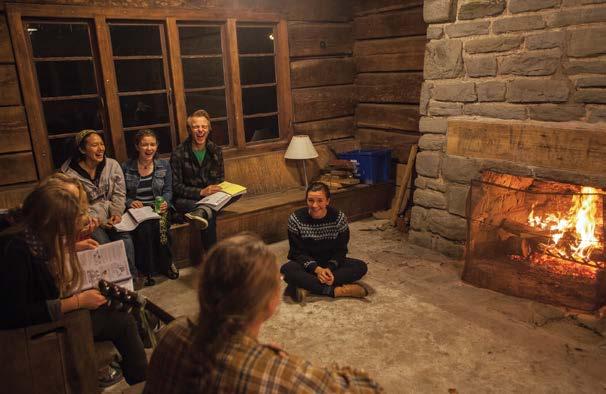
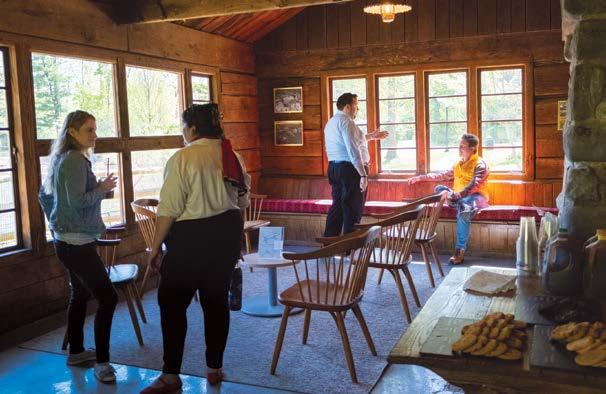
Members of the Haverford community visit the log cabin structure during a spring open house following a significant renovation conducted by the Arboretum and Facilities Management teams. The building was upgraded with a heating and cooling system and Wi-Fi, and the surrounding area was landscaped. A wood table made by Jayme Guokas ’97 from fallen trees on campus was donated by Steve Coleman ’84.
